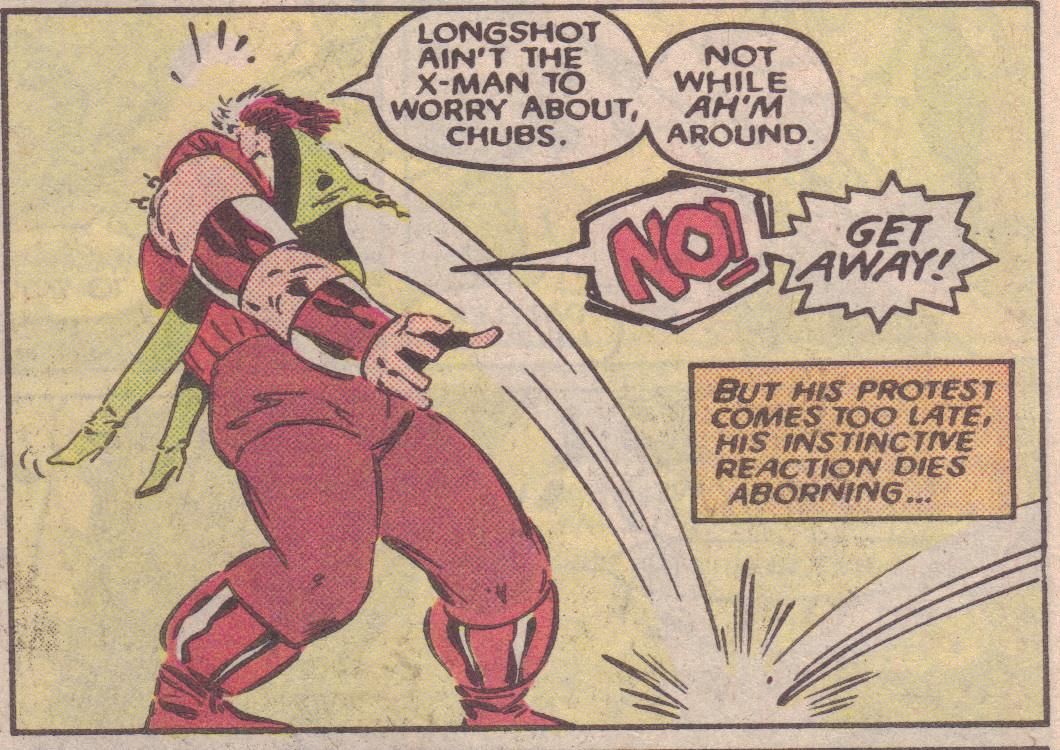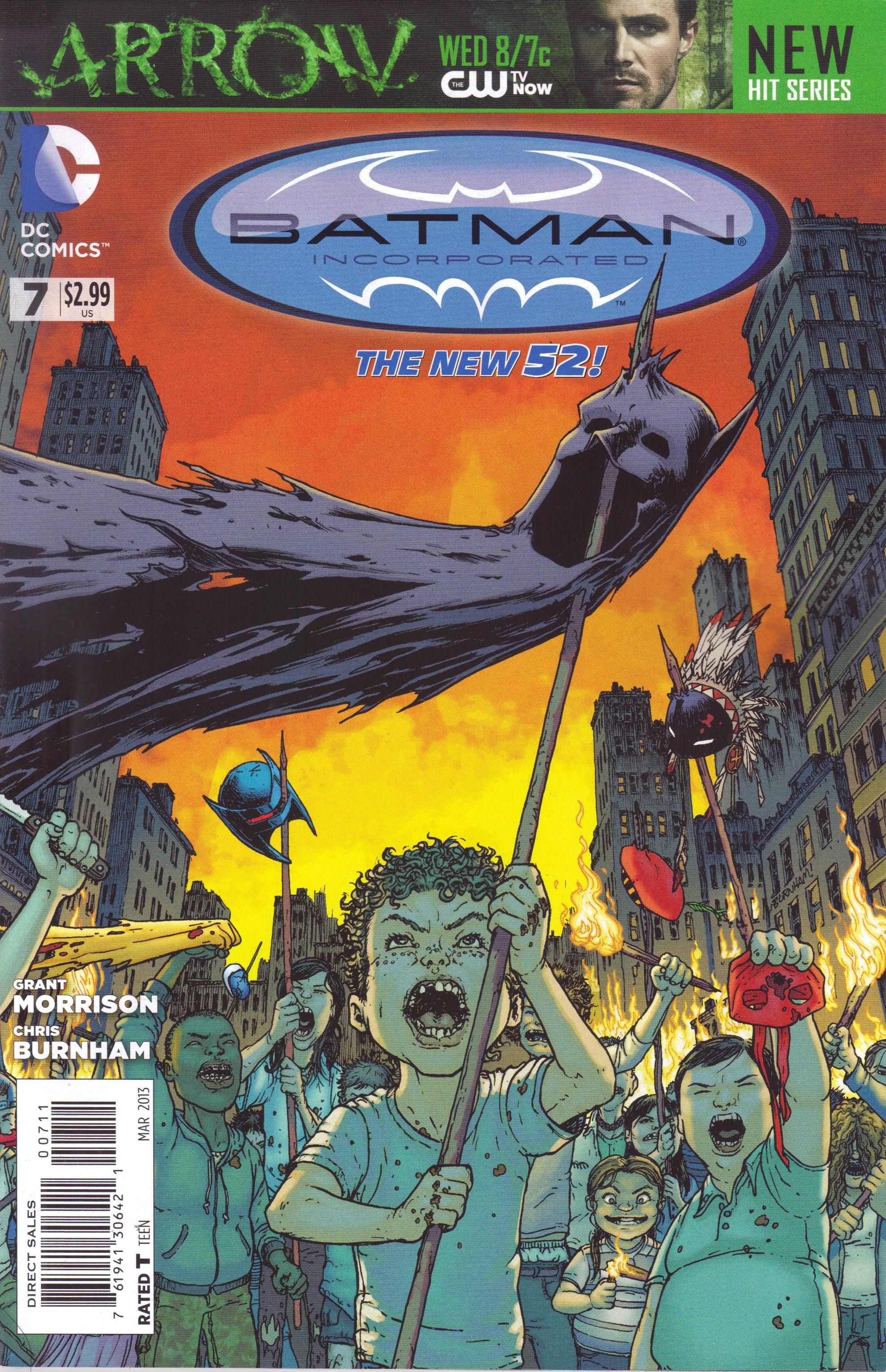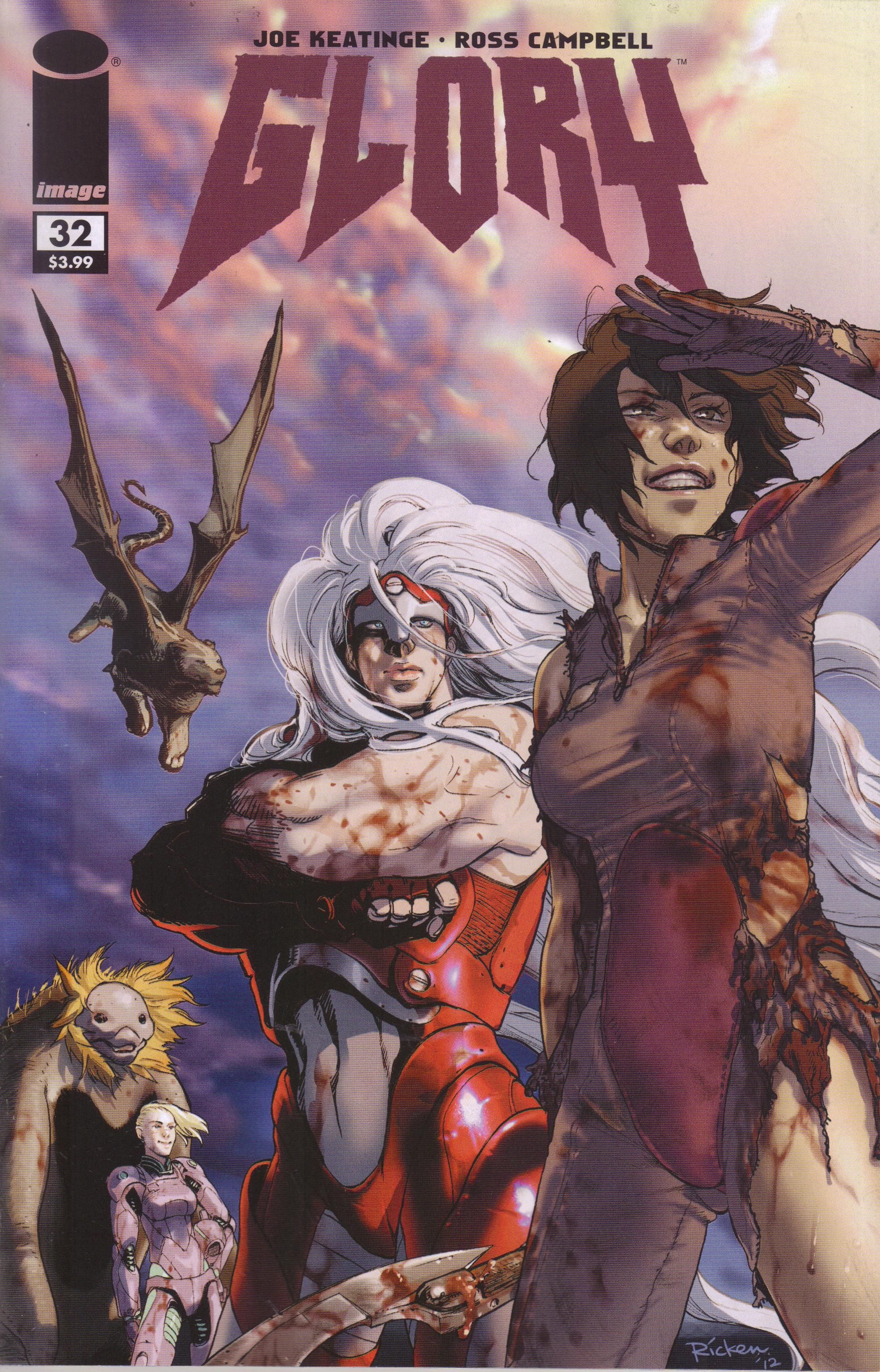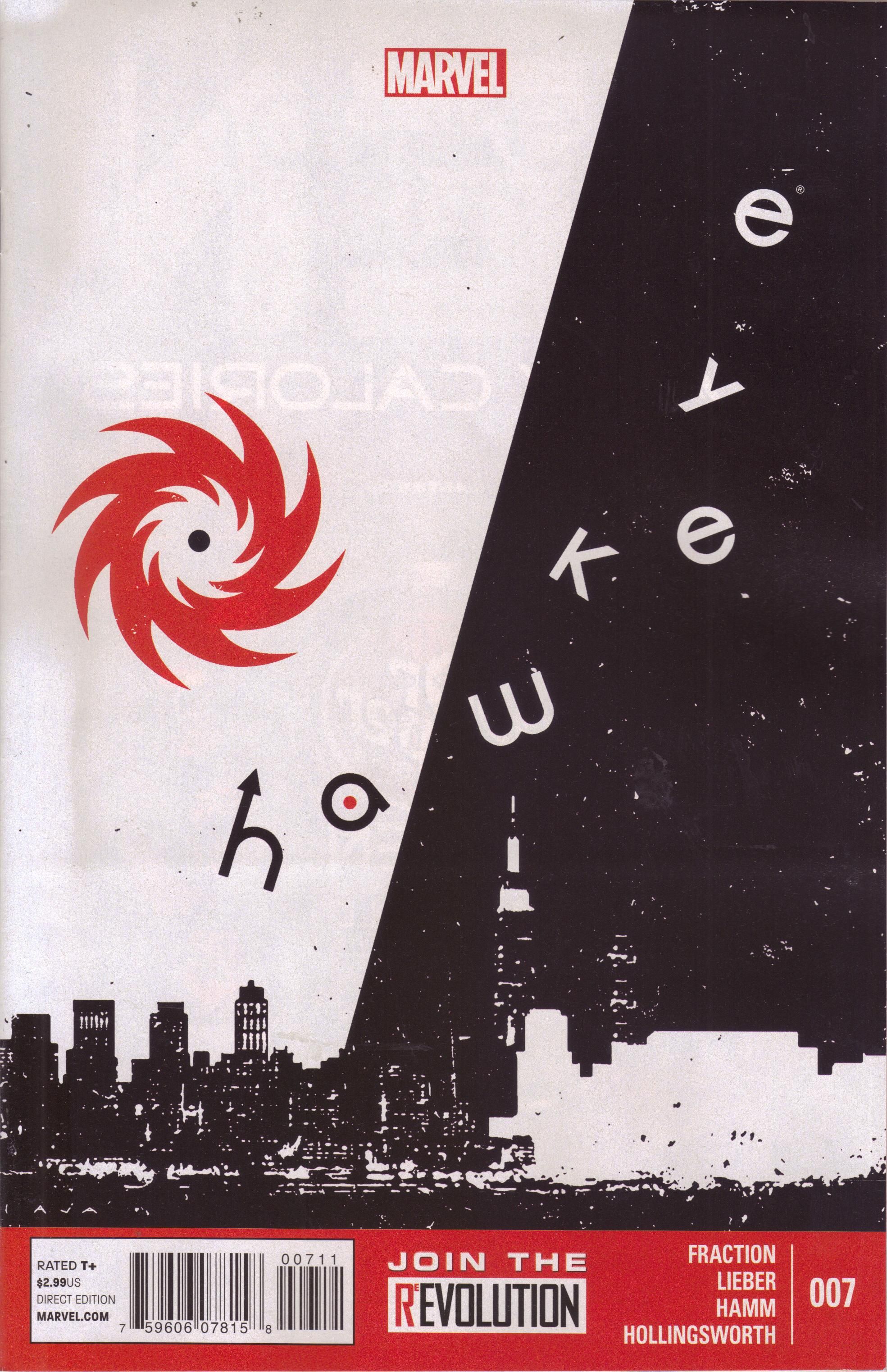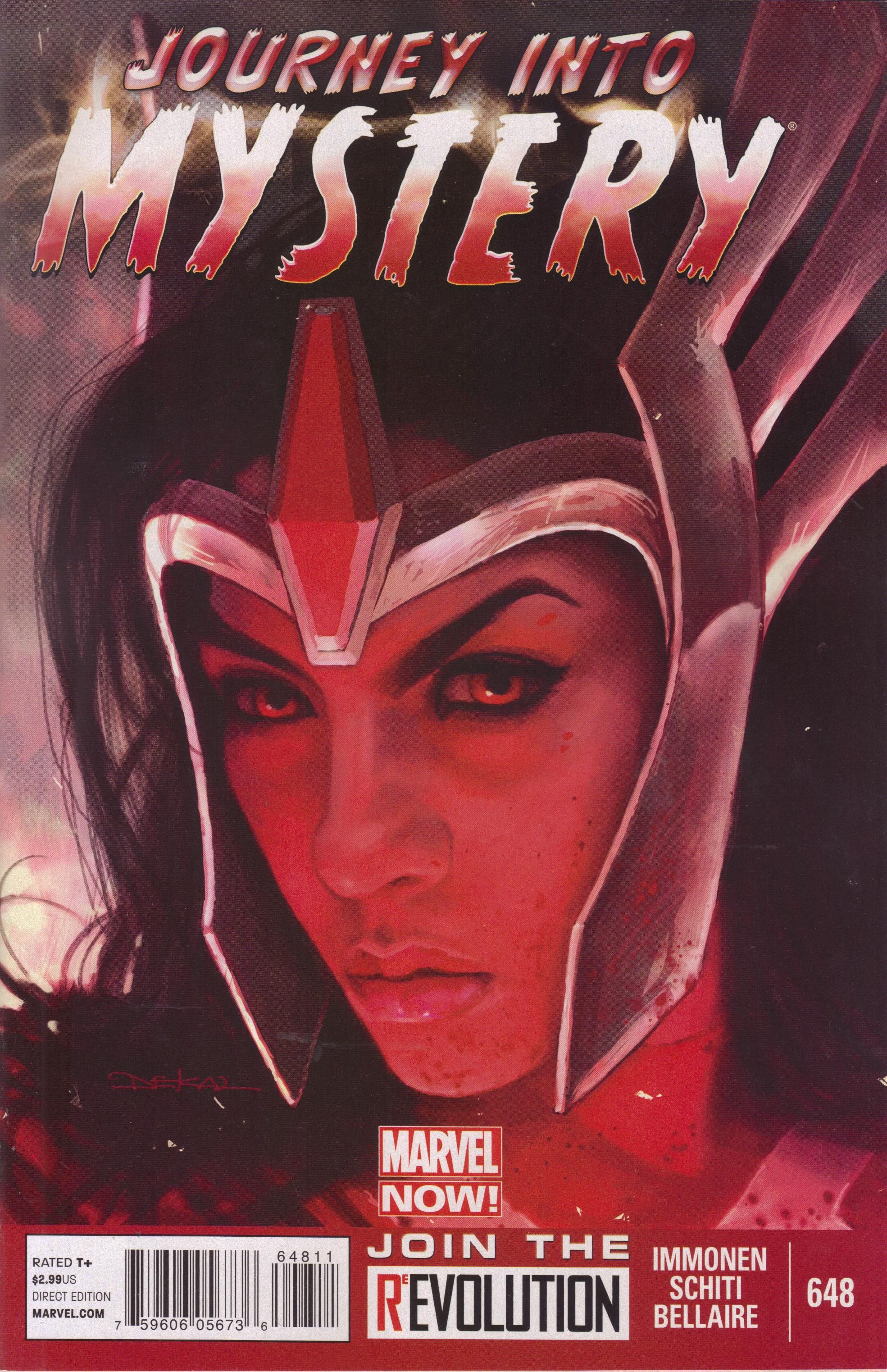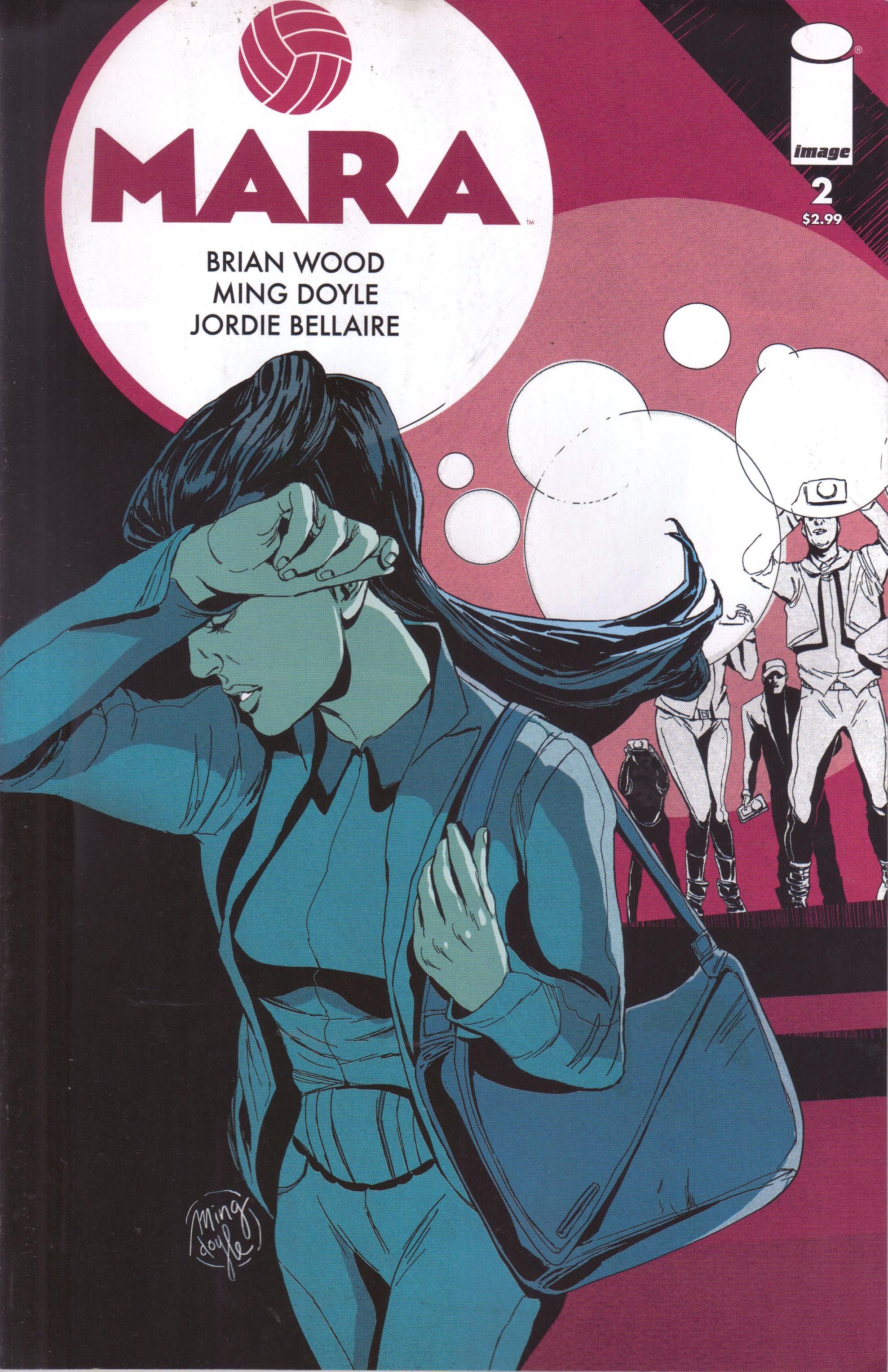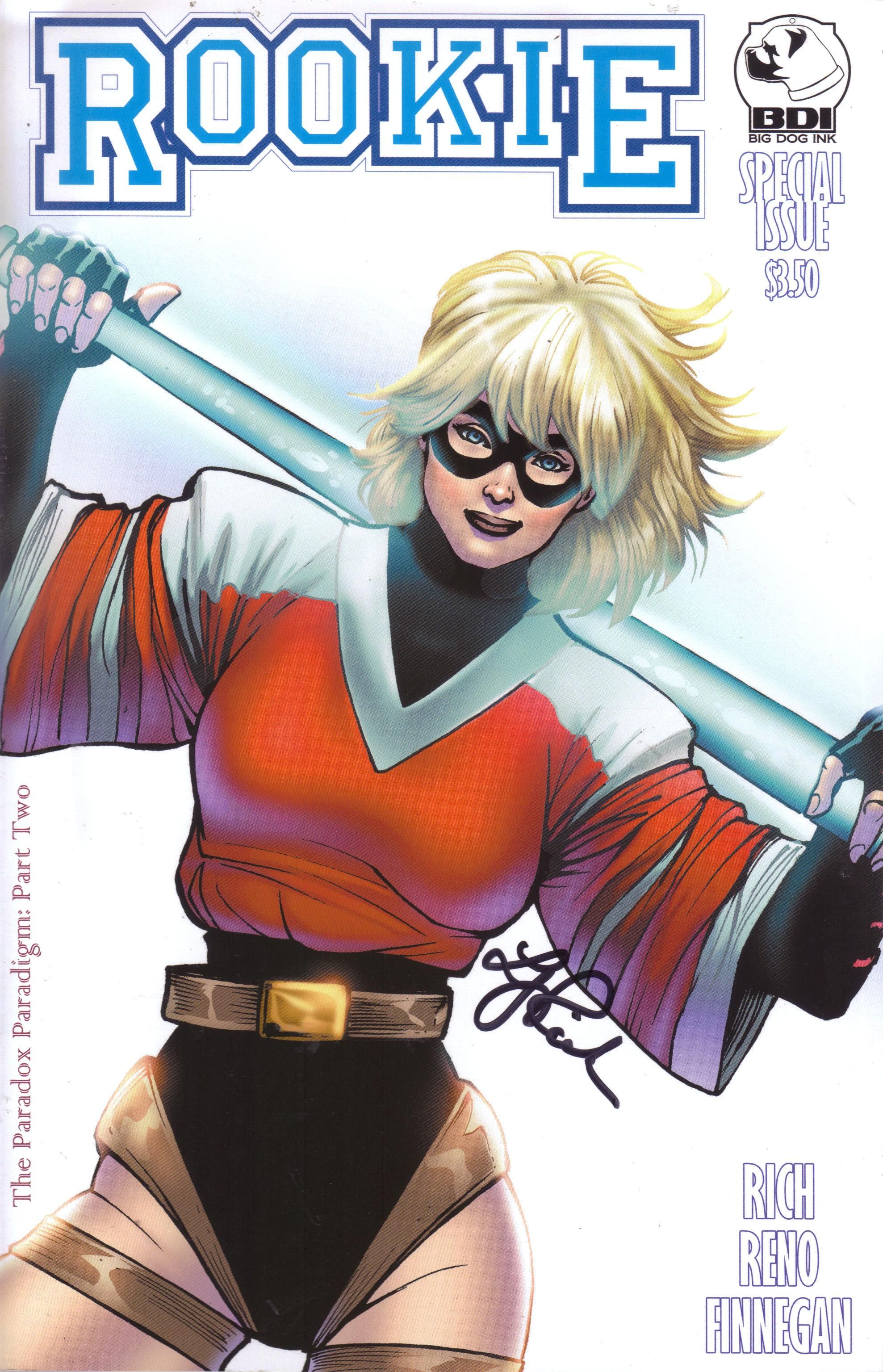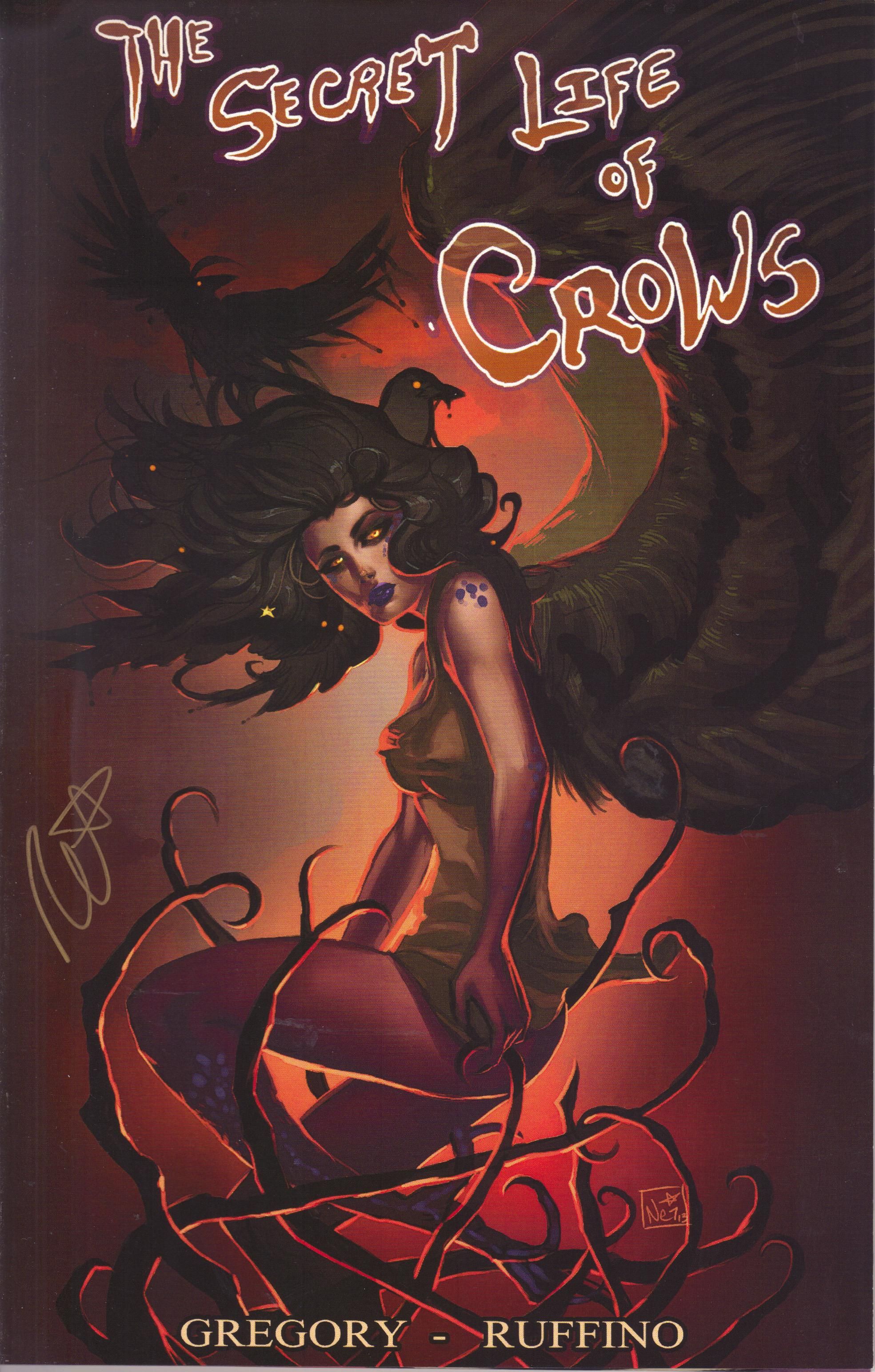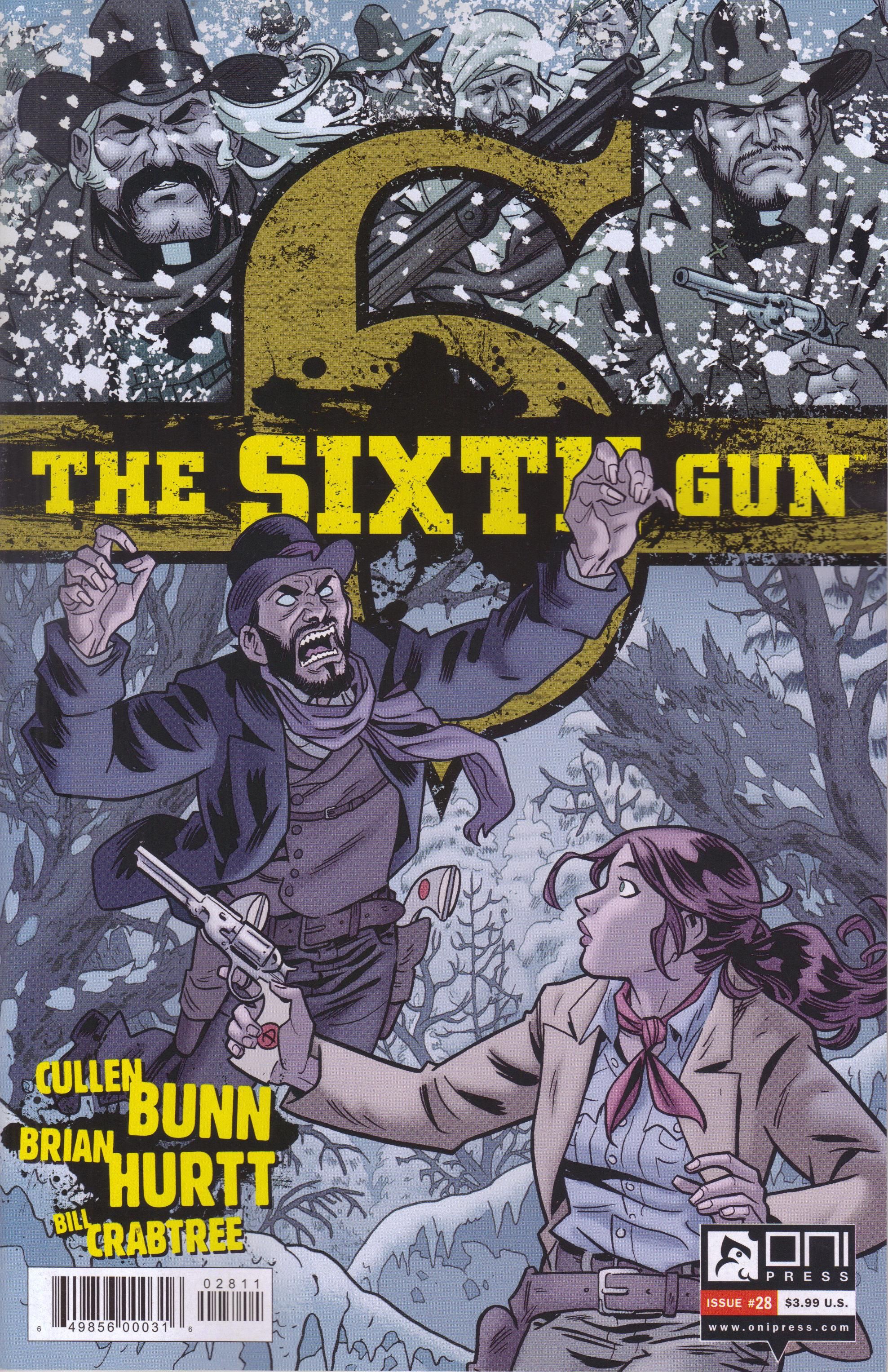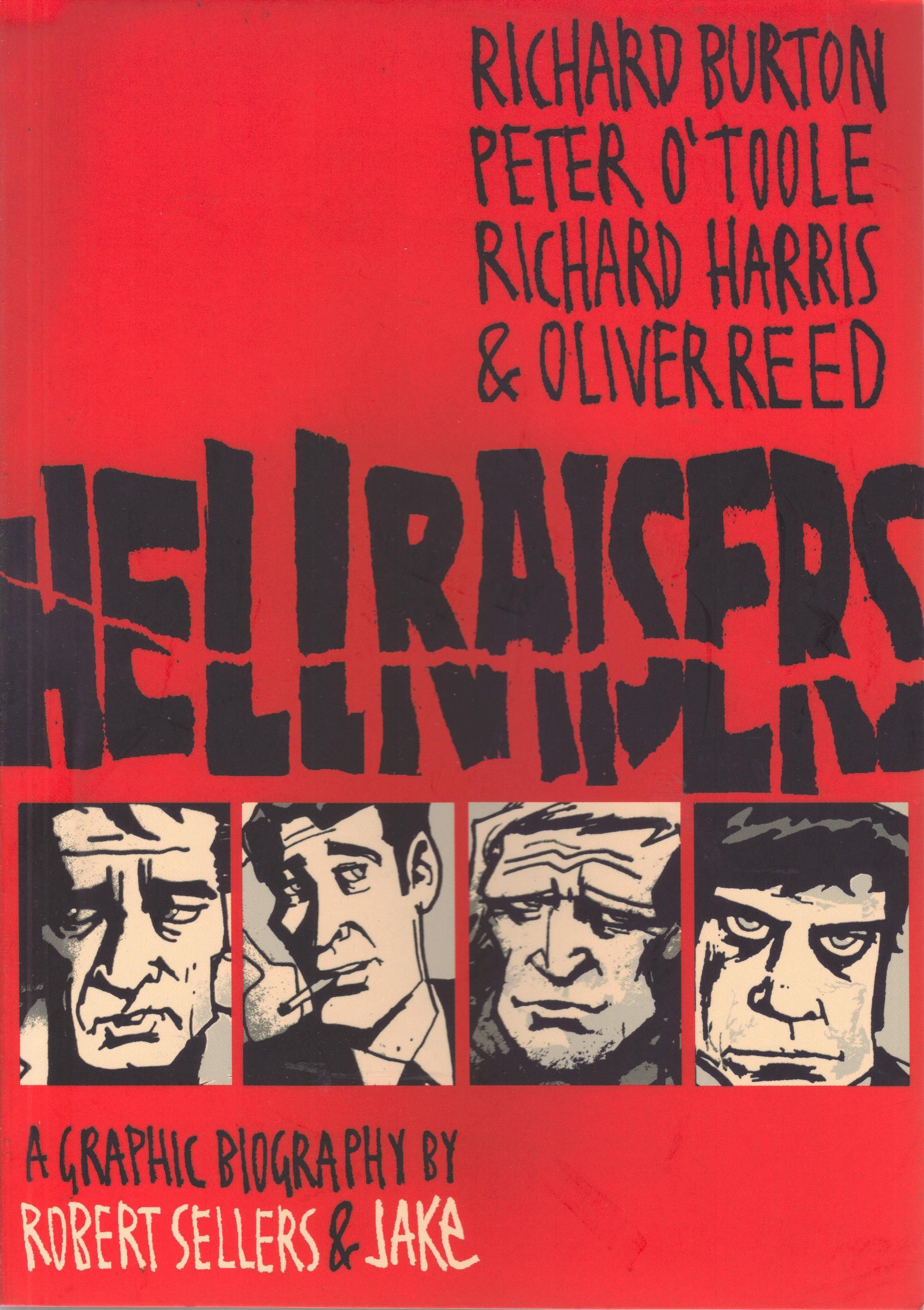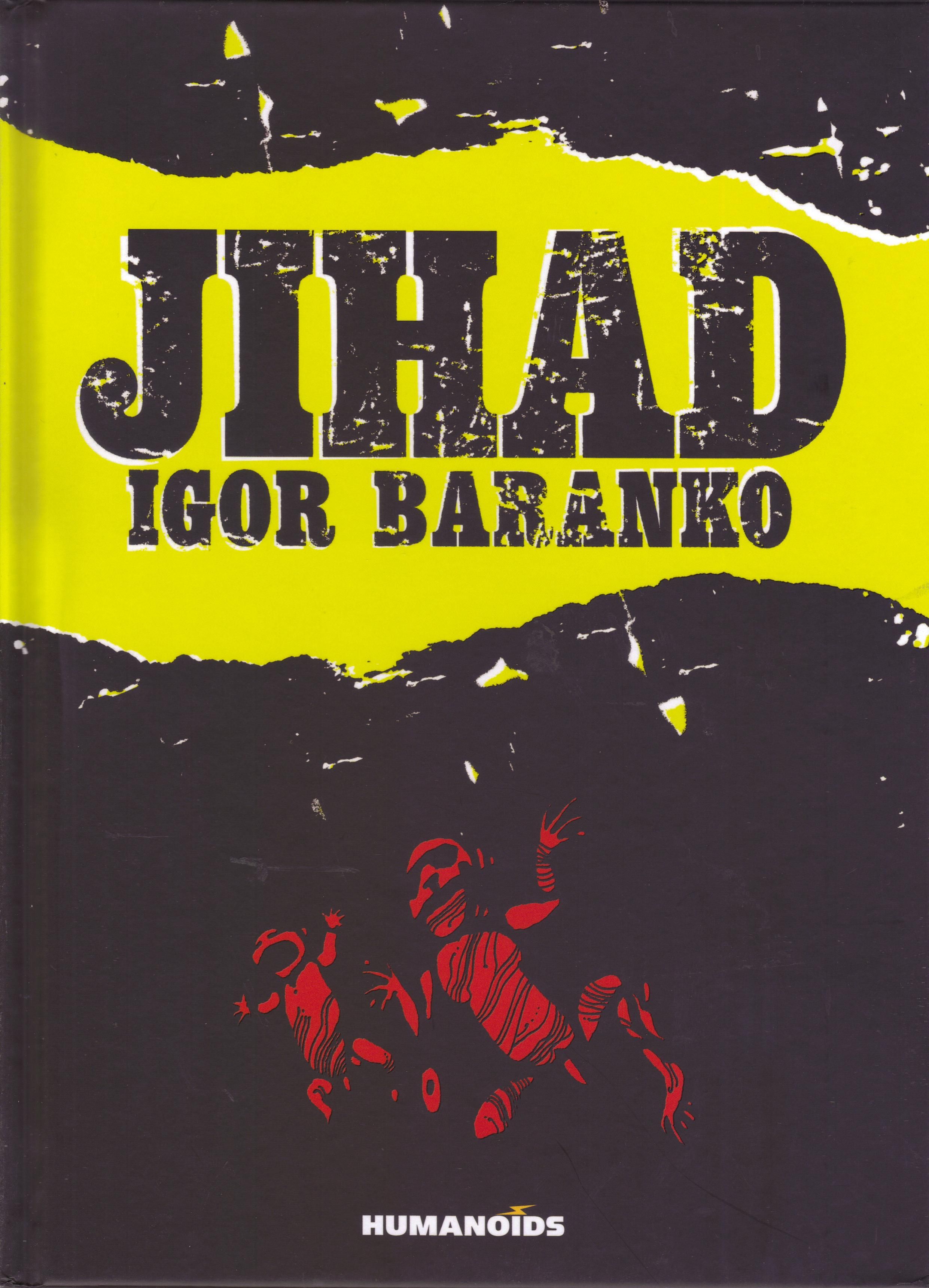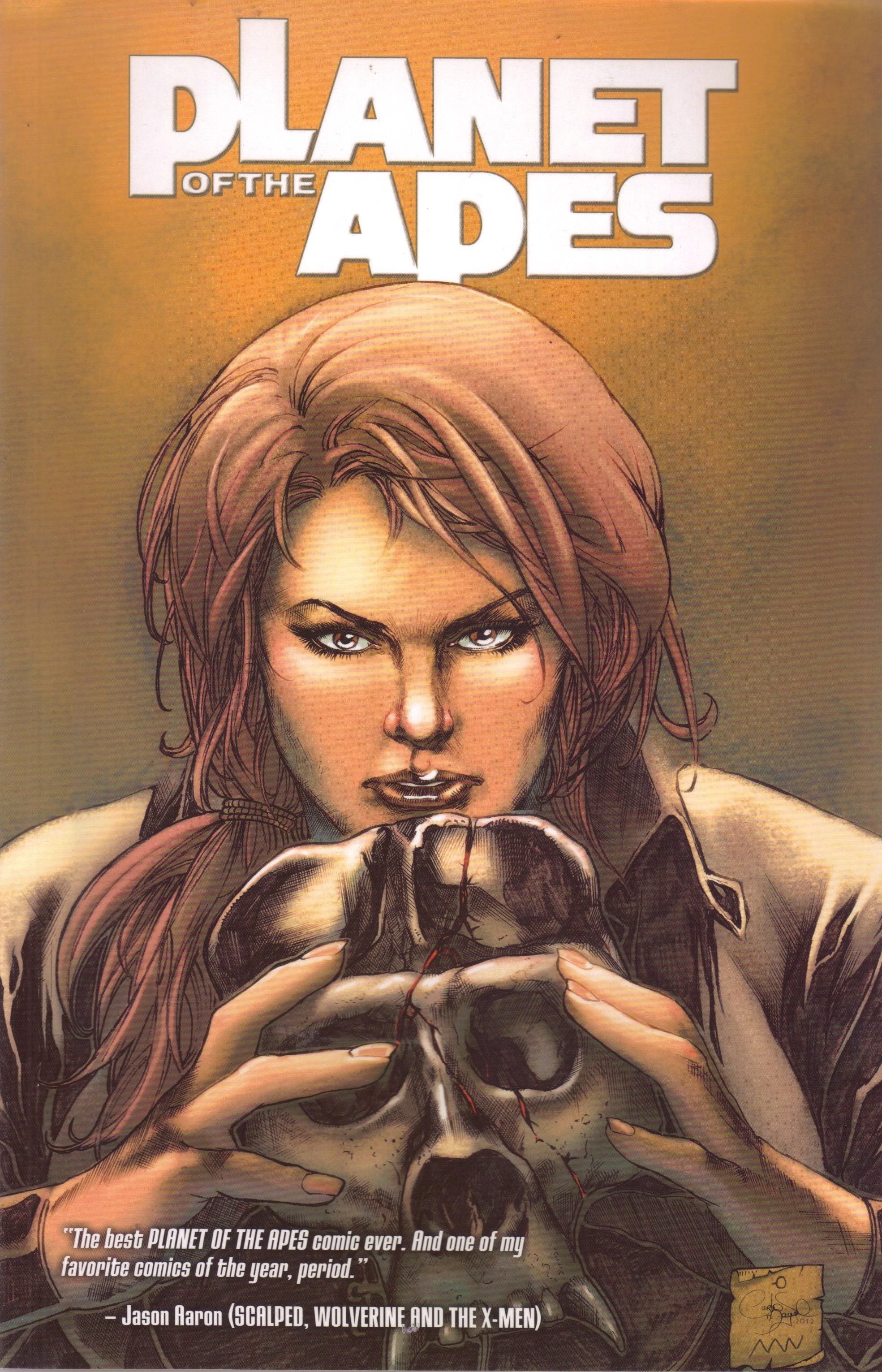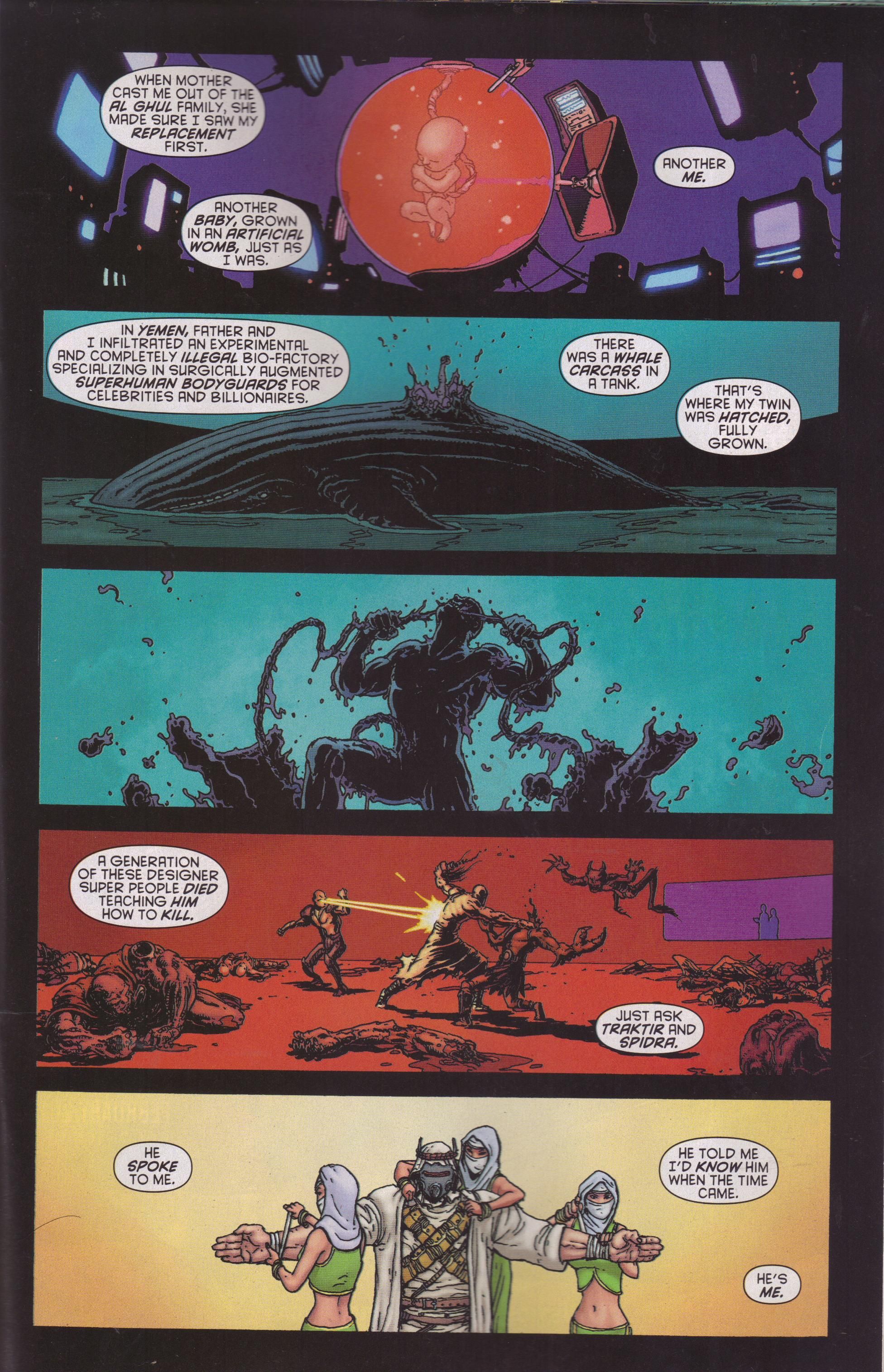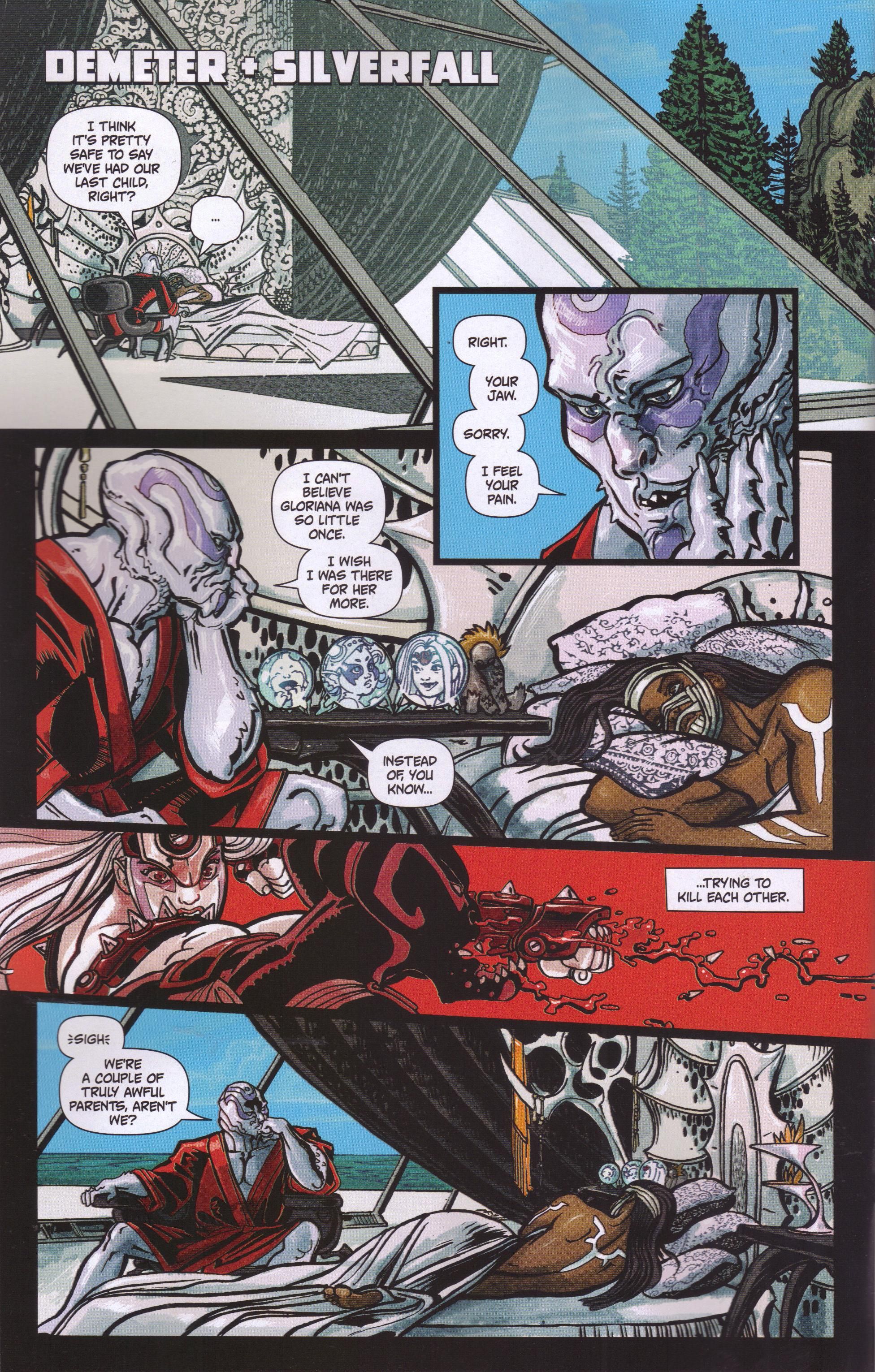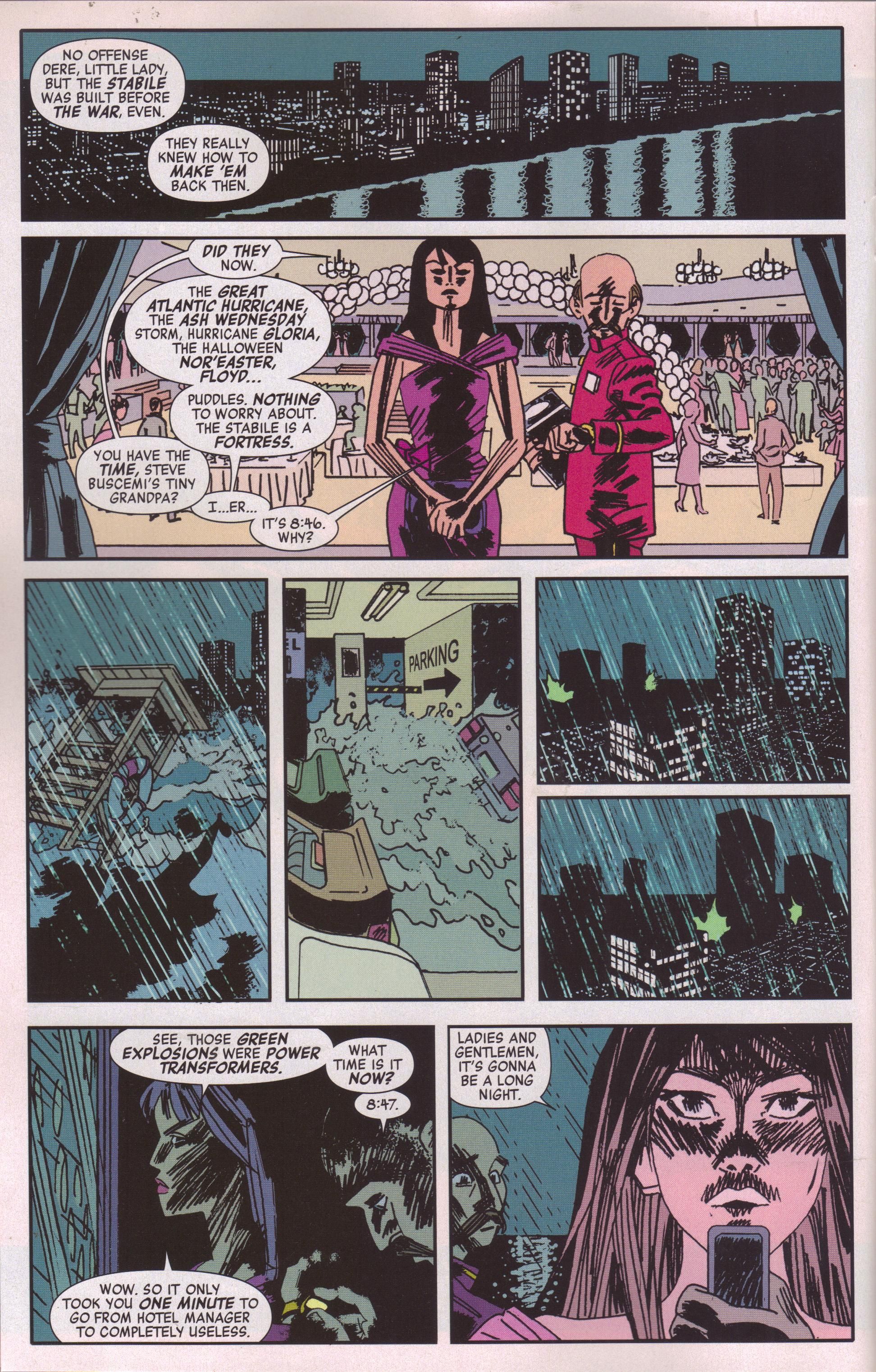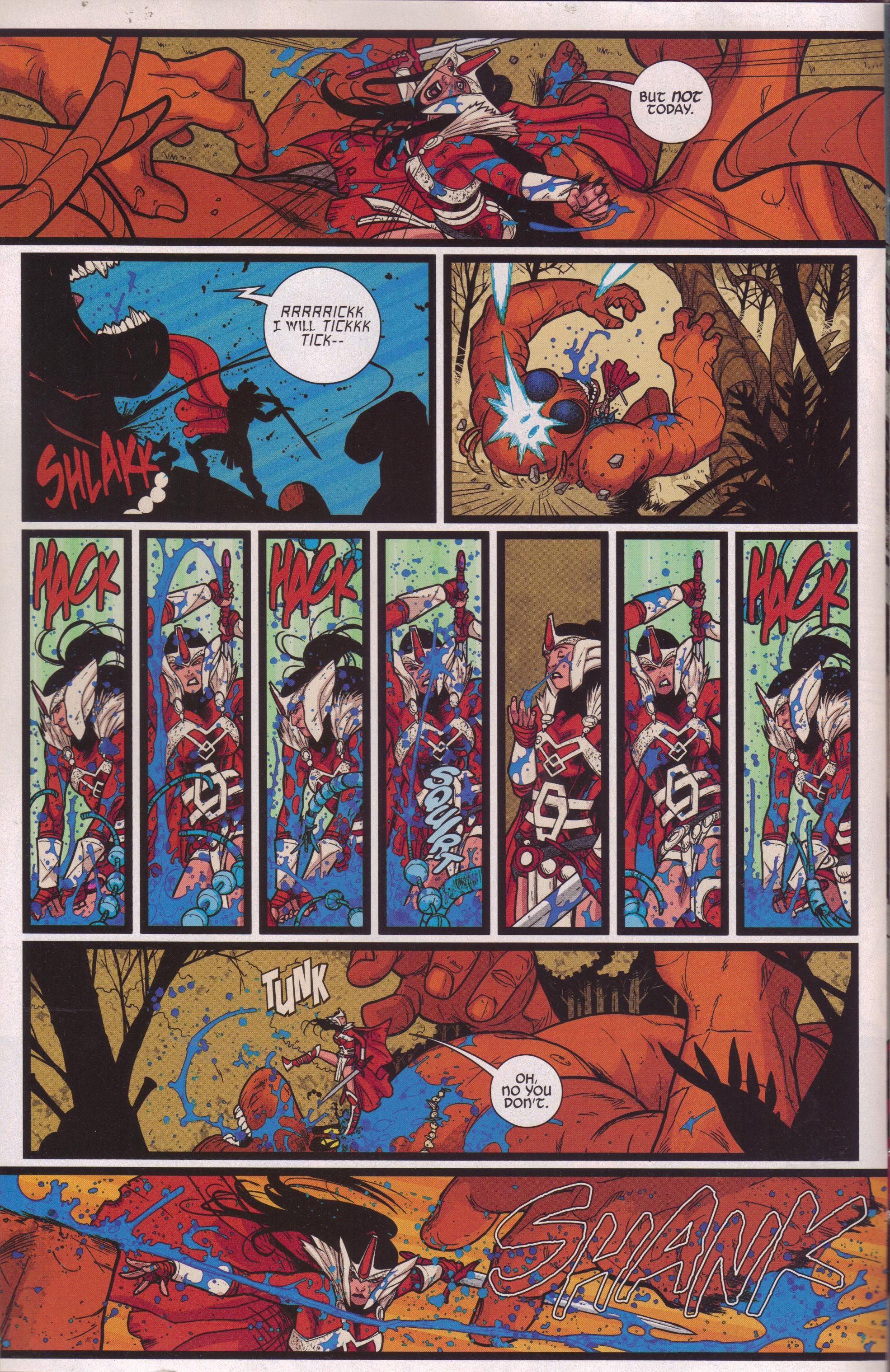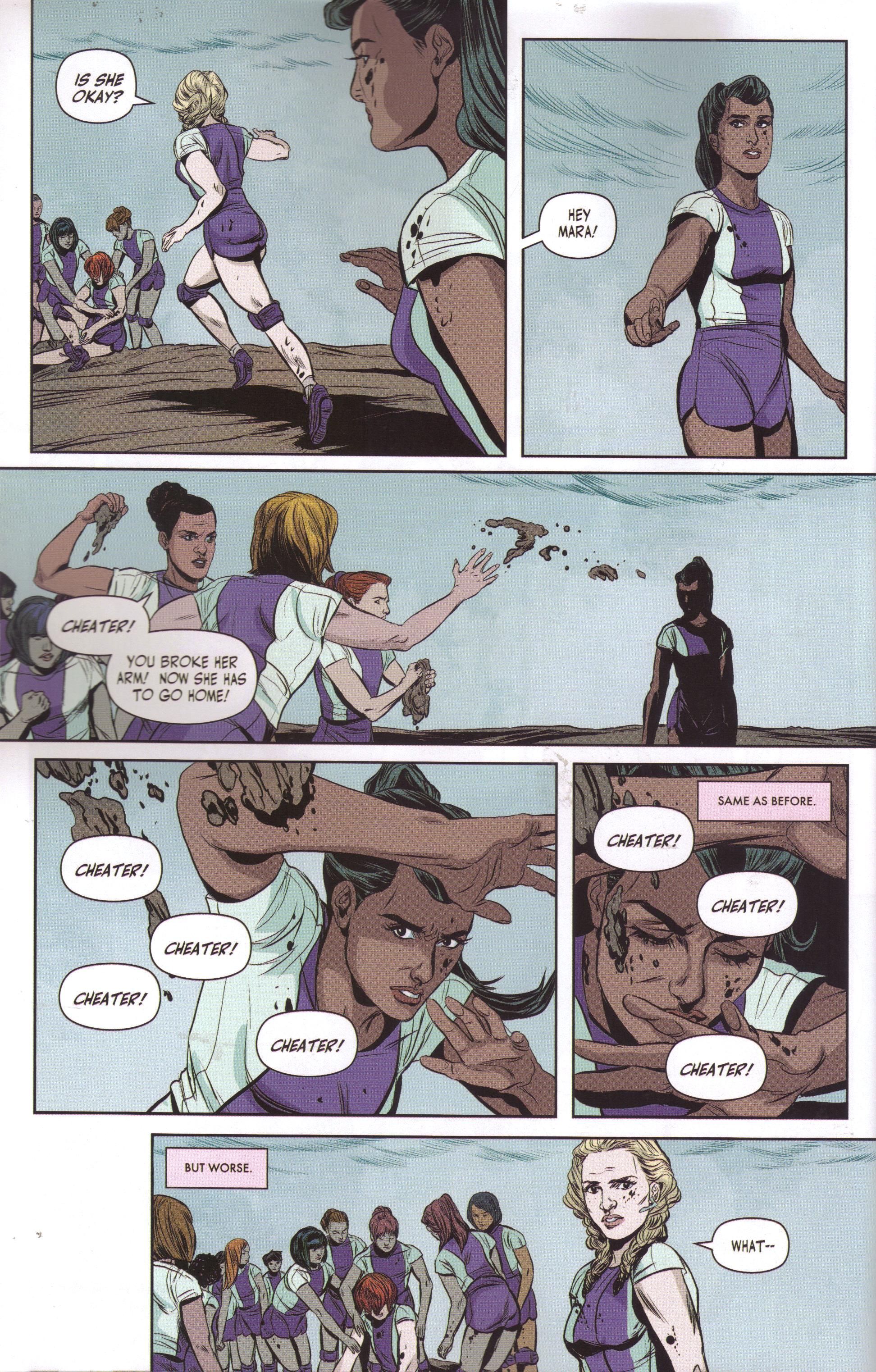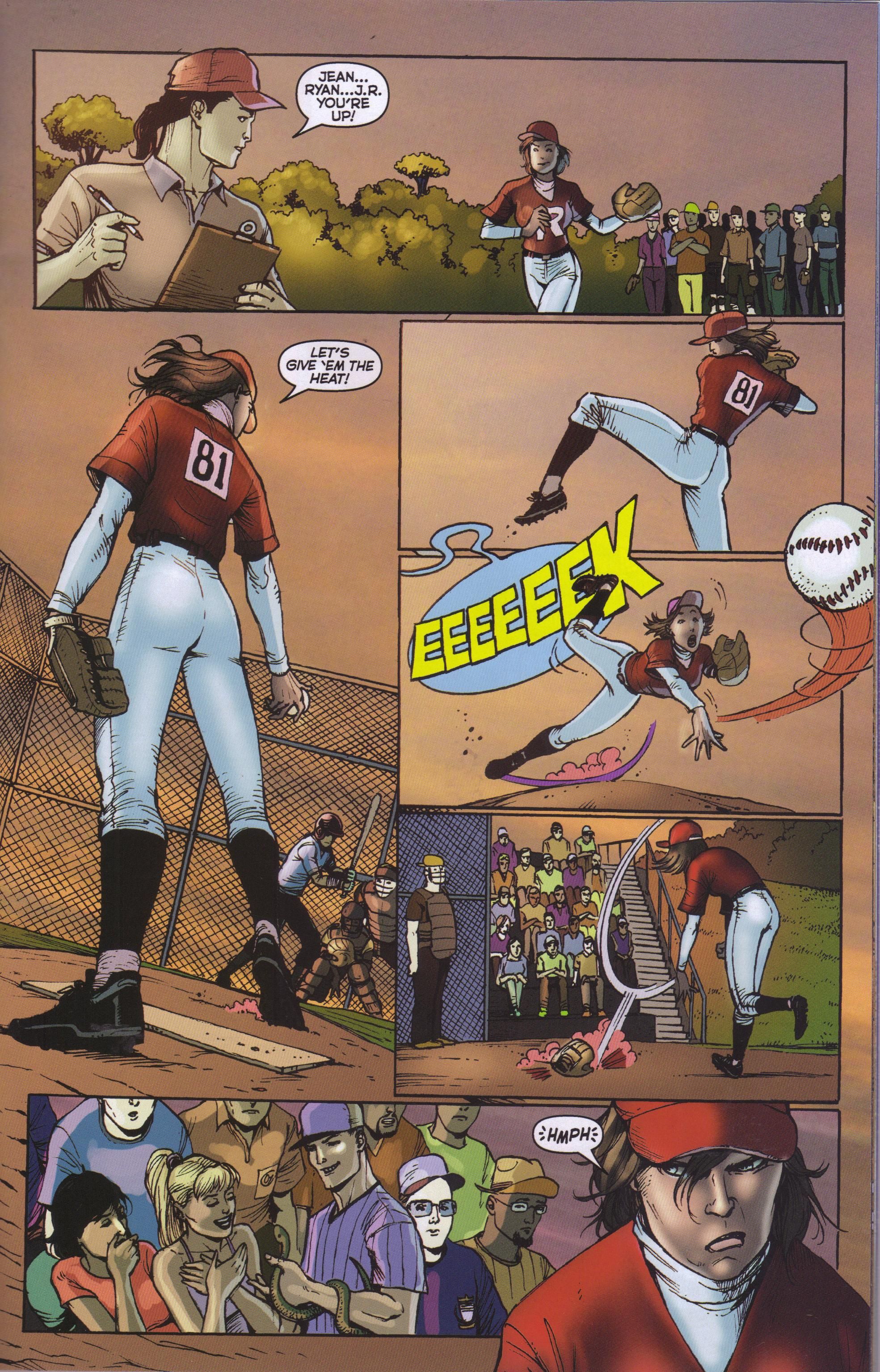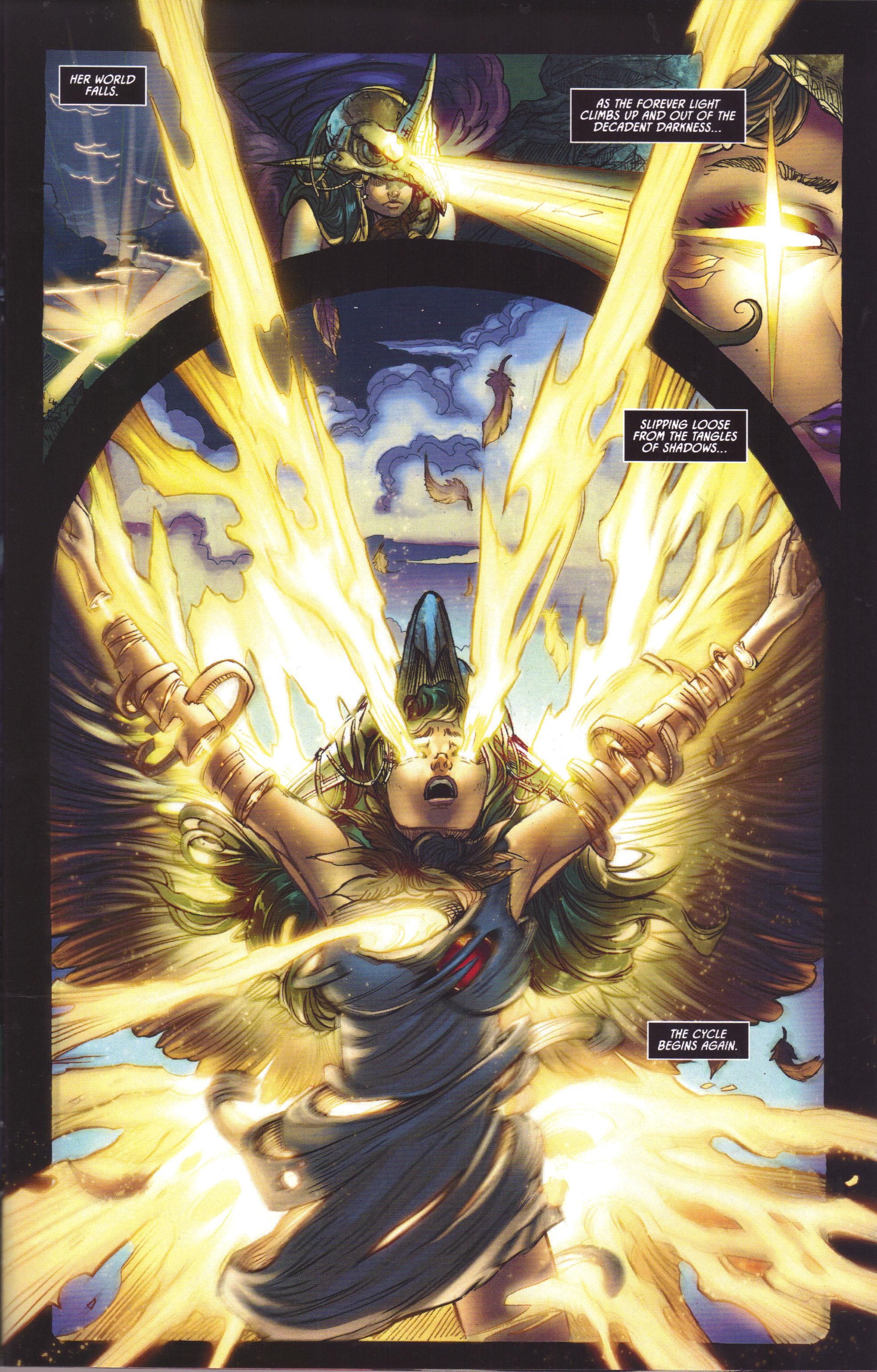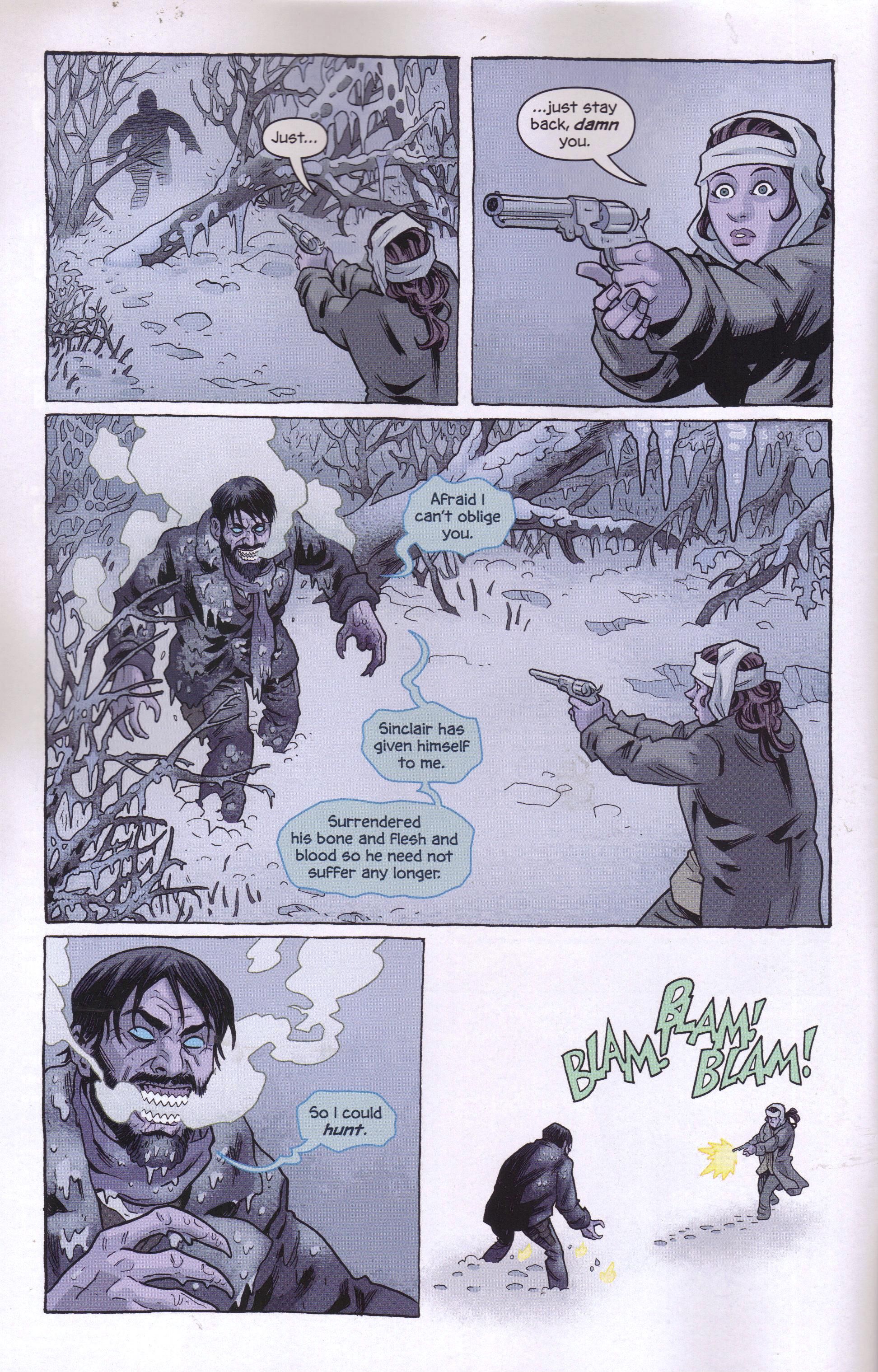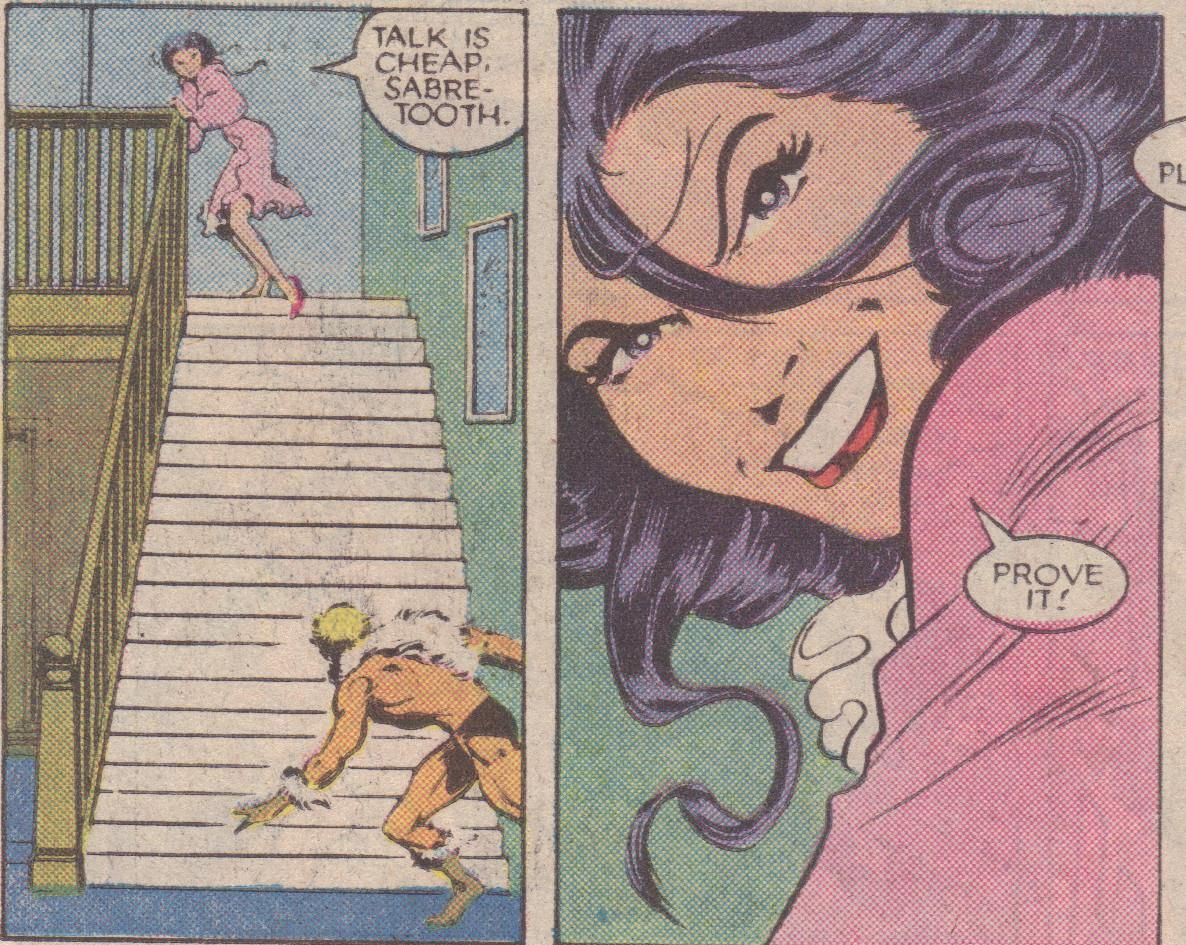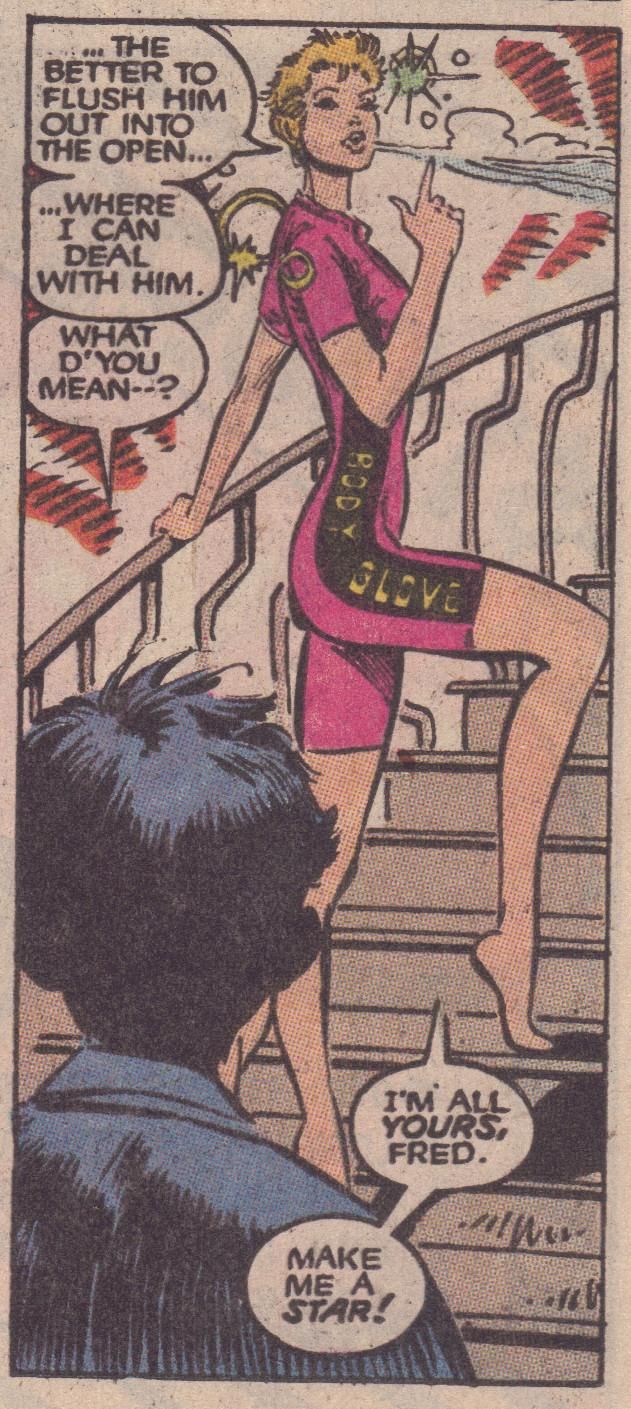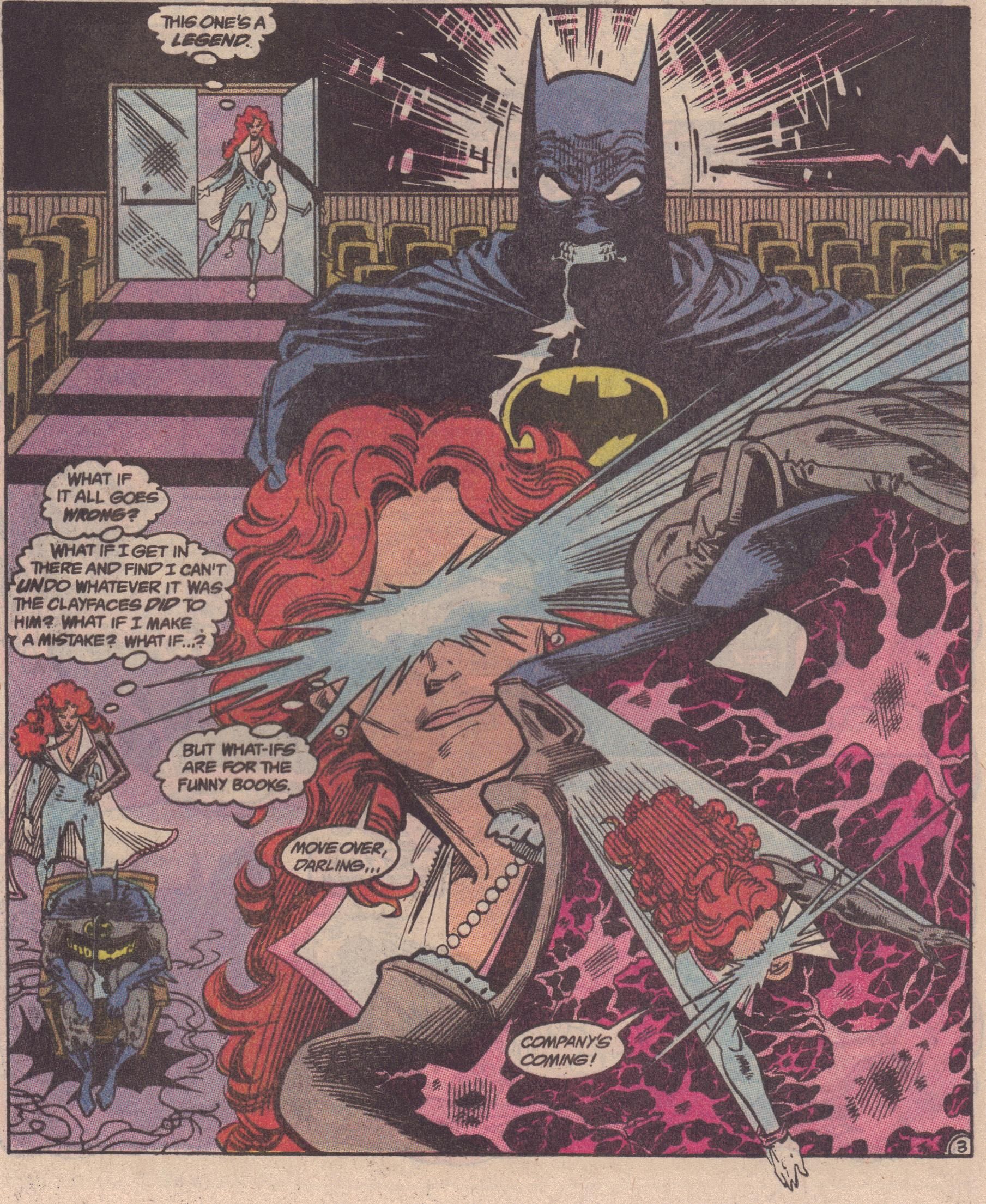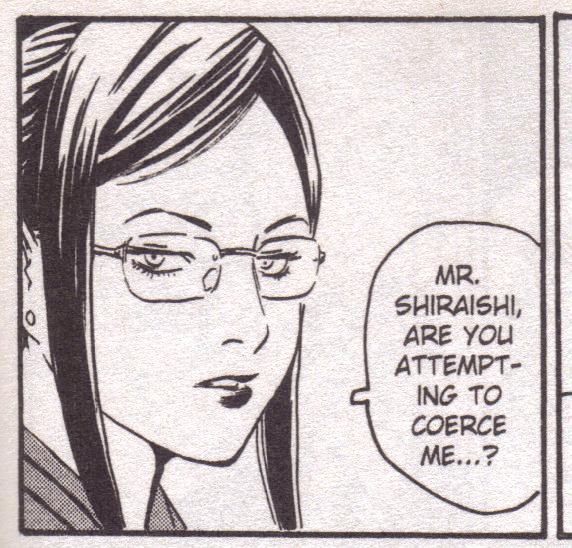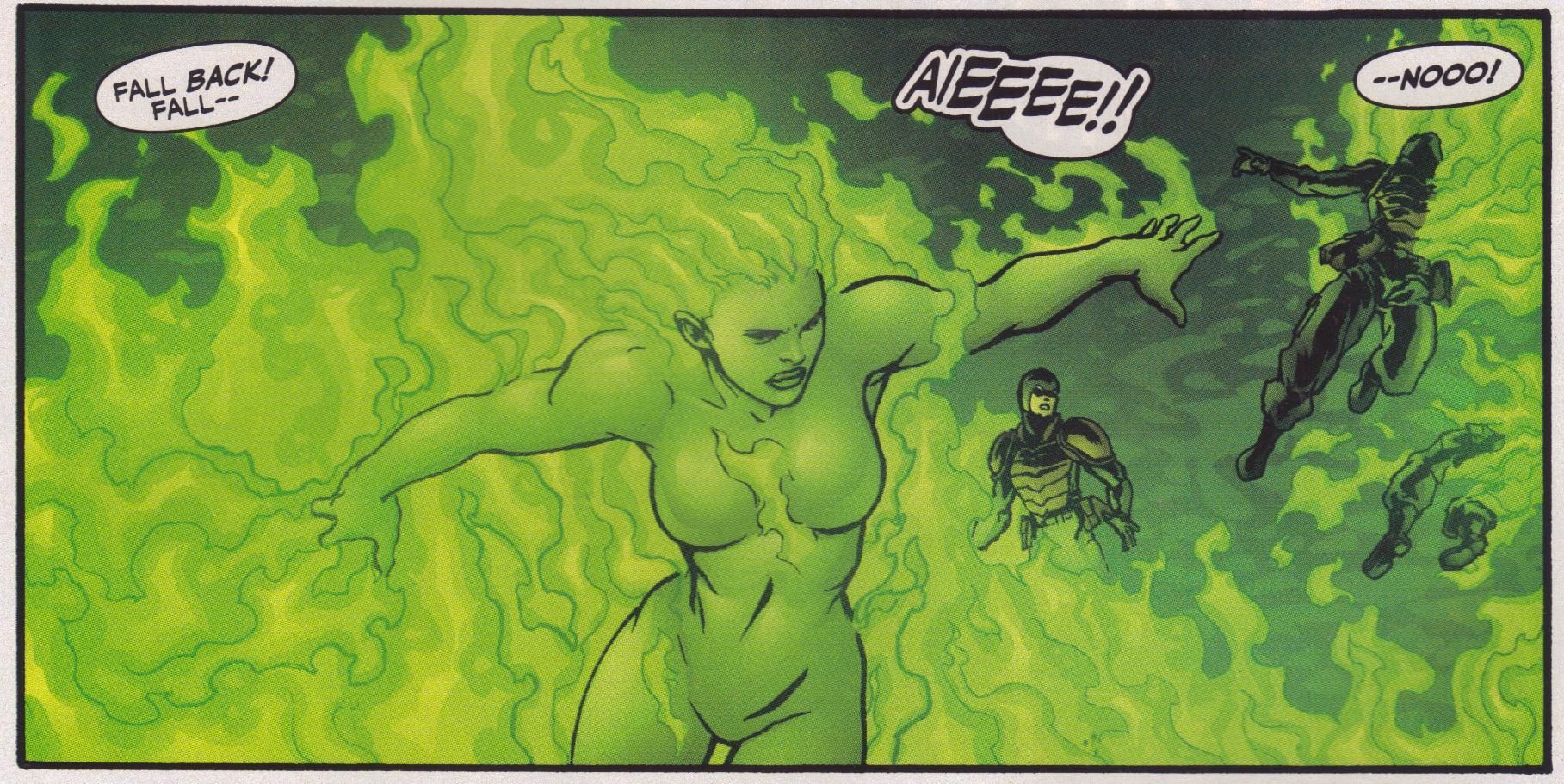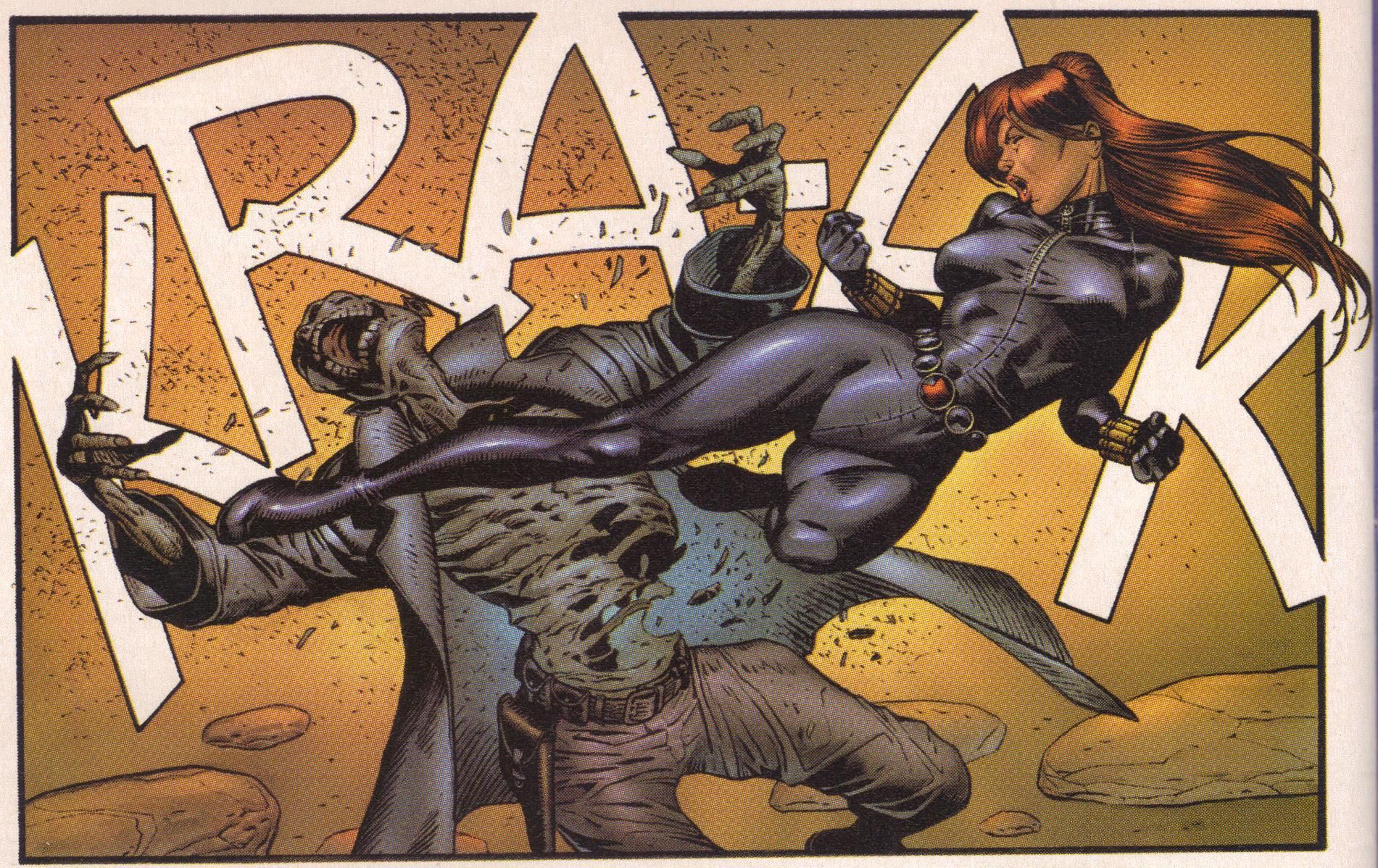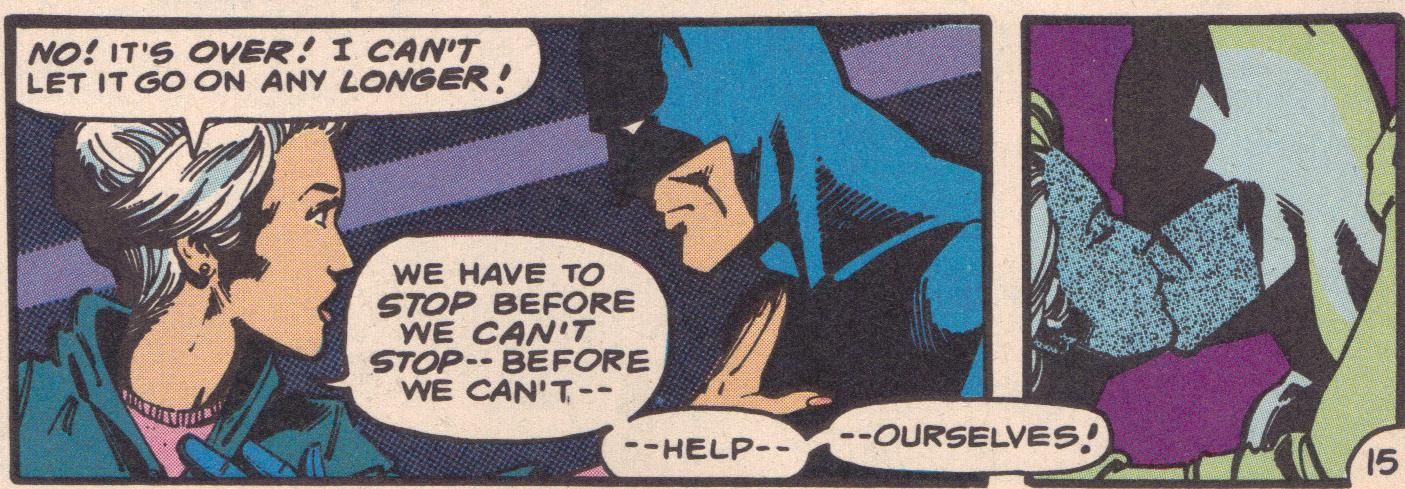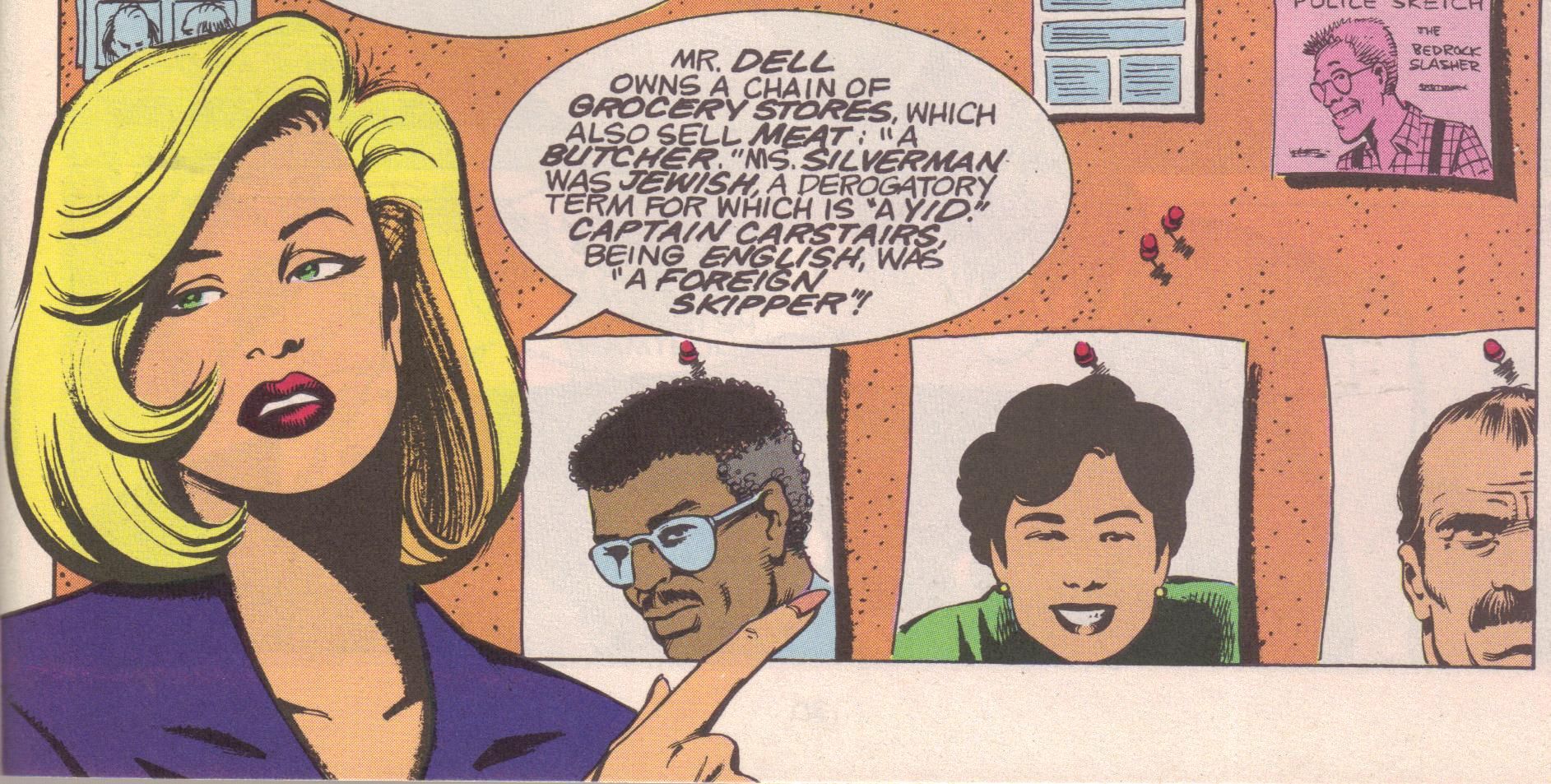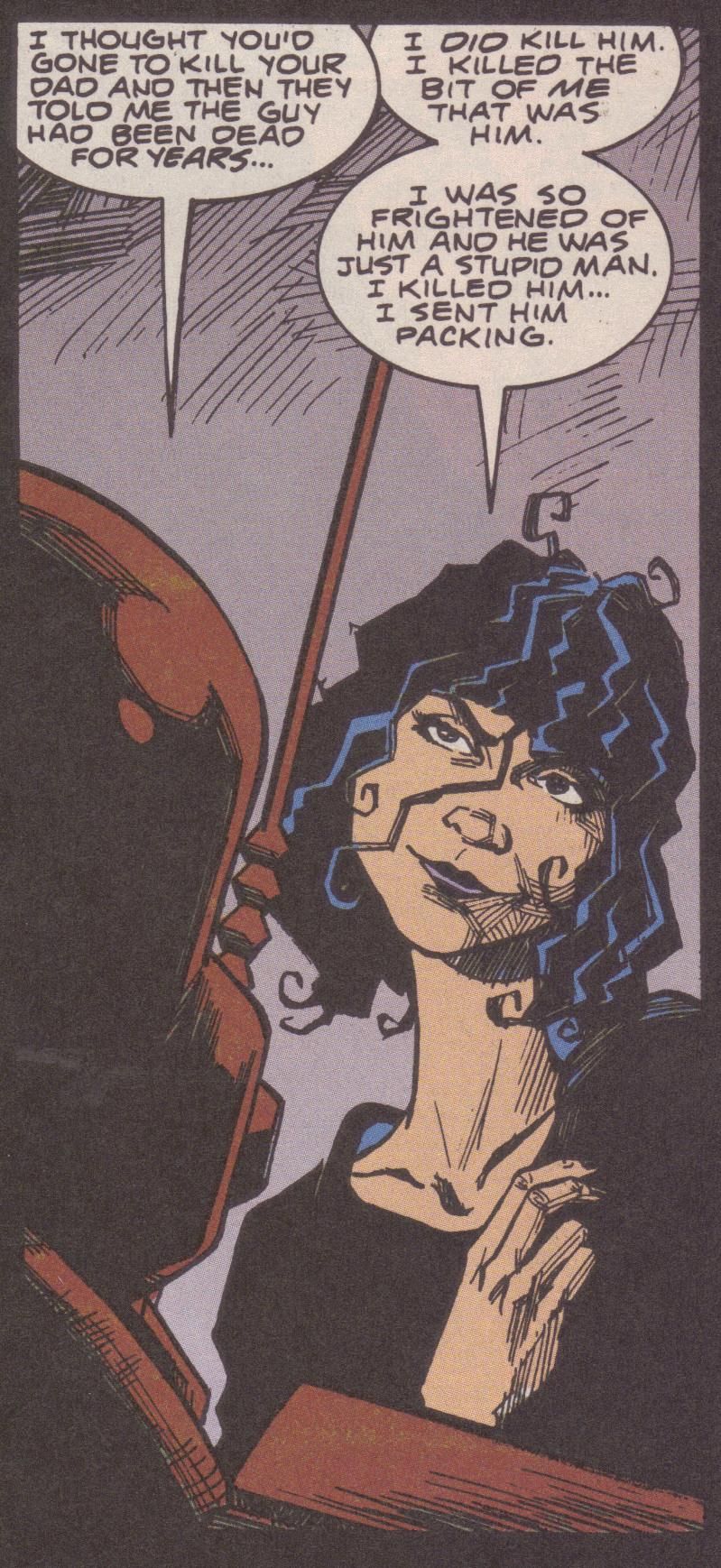At this point one may note that men must be either pampered or annihilated. (Niccolo Machiavelli, from The Prince)
Batman, Incorporated #7 ("Belly of the Whale") by Grant "Yeah, my bad guy gestated in a whale - you gotta problem with that, fanboys?" Morrison (writer), Chris Burnham (artist), Jason Masters (inexplicable artist of three pages), Nathan Fairbairn (colorist), Carlos M. Mangual (letterer), Rickey Purdin (assistant editor), and Mike Marts (editor). $2.99, 20 pgs, FC, DC.
Morrison is simply rounding up the usual suspects in this comic, as he checks in on every character who's relevant to this big "Leviathan" story arc he's been working on, presumably getting everyone in place for the big ol' climax that's coming soon. Batman is whisked away by one of Talia's man-bats, and then we check in on Traktir and Spidra, who are going to open a big can o' whup-ass on a bunch of Talia's minions; Dick comforts ... well, a person who lost someone close to them, and I would spoil it but I don't want to; Damian and Alfred; Jason, who is taken out by a traitor in their midst; Tim, who almost gets blown up and figures out that Talia is taking over Wayne Tower; and Talia, who has cleverly designed a trap for Batman that he will escape an instant too late. The crux of the issue is Damian figuring things out and claiming he's the only one who can stop Talia, and Alfred agrees with him. There are some typically clever Morrisonian phrases, but overall, this issue simply gets all his ducks in a row. It's not bad, but you can definitely see the clockwork. I was disappointed in the brief scene in Wayne Tower lobby, though. That's the only way the girl could escape, because the bad guys are so very stupid? Really?
I'm still not quite sure why artists are showing up for a page or two. Last issue and this issue had artists showing up for a few pages, and both artists tried to fit their style to Burnham's, and the pages they drew aren't obvious places for a different artist, so it's obvious Burnham simply couldn't finish the pages. I know that DC really wants to release their books on an almost Nazi-type schedule, but I can't imagine it takes so many more days for Burnham to draw a few extra pages, and Morrison doesn't really care about the DCnU in this book anyway, so why can't it ship a bit late? We've already had an issue of Batman, Inc. come out in January, anyway, so DC couldn't push this a week? It's very weird. Masters isn't terrible, but it's just strange seeing the slightest change in style for random pages throughout the issue.
So this is an okay issue, I guess, but it's kind of weird to read an issue by Morrison where so little happens. The dude likes to pack his comics with a lot of stuff, and this issue, compared to almost every other issue by Morrison, is almost Bendisian by comparison. Oh well. Can't win 'em all.
Rating: ★ ★ ★ ★ ★ ★ ☆ ☆ ☆ ☆
One totally Airwolf page:
The Heretic's "secret origin" is nicely done, although Burnham doesn't do too much with the page layout. The vertical line running down the center of the page is nice, though - from embryo to emergence to battle to preparation - with Fairbairn using the reds and blues well to get across a nice mood. Why is the Heretic gestated inside a whale? Because it's the God of All Comics, fools!
Glory #32 ("War Torn Part Two: Missing in Action") by Joe Keatinge (writer), Ross Campbell (artist), Owen Gieni (artist/colorist), Emi Lenox (artist), Sloane Leong (artist), Jed Dougherty (artist), Greg Hinkle (artist), Charis Solis (colorist), and Ed Brisson (letterer). $3.99, 20 pgs, FC, Image.
For the penultimate issue of Glory (so sad!), Keatinge lets all his characters make peace with their ... well, not gods, but when Glory's dad tells them they're probably all going to die, Riley says it might be nice to collect their thoughts. So the entire issue is checking in on the various characters. It's really just an excuse to get a bunch of artists to draw a couple of pages, but it's still a charming issue. Riley checks in with a friend of hers, and we see how fragile she still is. Henry inexplicably ends up in Emi Lenox's universe, and he gives her a camera. Gloria meets a dude with no facial features except eyebrows who gives her something that might be important during the battle. Nanaja bonds with her baby sister. Glory's parents get busy. Glory calls reinforcements, which leads to a pretty keen final page. It's not the best issue of Glory, but Keatinge is, like Morrison, getting all his ducks in a row. Next issue is the last one. I predict bloodshed.
[Edit: I forgot that there are TWO issues of Glory left, not one. My bad. But now I'm happy, because there are two more issues, not just one. Yay!]
Rating: ★ ★ ★ ★ ★ ★ ☆ ☆ ☆ ☆
One totally Airwolf page:
This page is by Greg Hinkle, who's a pretty good artist. He's channeling Campbell a bit, but he has a slightly thicker and clunkier line than Campbell does (I say that in the nicest way possible, "clunky" isn't perjorative, I don't think). The flashback panel is nicely colored, and notice how Hinkle links the flashback with the panel below it - they're both moving left to right well, but Glory in the flashback is replaced by her father, who talks about what bad parents they are. The red in Silverfall's robe links the two panels even more. There's a nice flow to the entire page, and Hinkle manages to show three different angles in the final three panels, but they all flow the same way. Clever, that.
Hawkguy #7 by Matt Fraction (writer), Steve Lieber (artist), Jesse Hamm (artist), Matt Hollingsworth (colorist), Chris Eliopoulos (letterer), Sana Amanat (associate editor), and Stephen Wacker (senior editor). $2.99, 20 pgs, FC, Marvel.
Fuck it, right? I mean, can I really write anything negative at all about this issue that won't make me sound like a jerk? Probably not. Fraction is giving a "portion of his proceeds" from this issue to the Red Cross, so fuck me if I say it's not awesome, right? It's a story about Hurricane Sandy (no, I refuse to call it "Super Storm Sandy") and what happens when Clint and Kate, in two different stories, are caught in it. Some of it doesn't make sense (I assume Kate is going to pay for the medicine and not "loot" the pharmacy, but to whom will she give the money, because if she leaves it on the counter, it's going to get stolen), some of it's far too cute (the people celebrating their engagement need to be smacked because of their names), some of it's too mawkish, but overall, it's a good issue. Both Lieber and Hamm do a good job - Lieber's story is a bit more serious than Hamm's, so his more "realistic" style works well for that, while Hamm's more cartoony style is good for Kate's adventure. It's not the best issue of Hawkguy, but that's not really the point, is it?
Rating: ★ ★ ★ ★ ★ ★ ☆ ☆ ☆ ☆
One totally Airwolf page:
Hamm's work on this page is solid, especially the way he "lights" Kate's face in the final panel, but Fraction's crisp writing is what makes the page fun. Sure, Kate is being a bitch, but it's still a nice burn. I like her calling the manager "Barton Fink" on the next page (although it's a case of a person referencing something that I'm not sure she would know about), but "Steve Buscemi's tiny grandpa" isn't bad, either.
Journey into Mystery #648 ("Stronger than Monsters, Part 3 of 5") by Kathryn Immonen (writer), Valerio Schiti (artist), Jordie Bellaire (colorist), Clayton Cowles (letterer), Jake Thomas (associate editor), and Lauren Sankovitch (editor). $2.99, 20 pgs, FC, Marvel.
Last month, Immonen dropped Sif into a weird world where she was immediately attacked by a monster. The recap page claims it's a robot, but I don't recall if that was established in the last issue, and I don't feel like looking it up. Anyway, she dispatches the robot/monster (see below), and then discovers other Asgardian bezerkers, who were sent to the world to guard Asgard against all these weird monsters. They are very proud of themselves, but they've lost a bit of the berzerker spirit over the centuries, and Sif has it in spades - she's new to the berzerker thing, after all. We learn that Heimdall's actions in sending her away has created an imbalance, as Aerndis puts it, and that lets Sif and her three berzerking comrades to escape to ... Earth. Well, of course they do! Where they're accosted by Spider-Ock. Because guest stars are the bread-and-butter of Marvel comics, yo!
This continues to be a ridiculously fun comic. Schiti and Bellaire are killing it on art, as Sif's battle with the monster is tremendous, Aerndis's predicament is hilariously delineated, and there's a lot of wonderfully expressive body language in this issue. Schiti really does a superb job showing Sif's manic mood changes, and he also does a nice job with the old berzerkers who've lost their taste for battle. Meanwhile, Immonen's script is just good comics writing. The first page is hilarious and a nice parody of comics narration that takes itself far too seriously, plus she does some good expositing without it seeming too forced. The reaction of the New Yorkers to the latest incursion is very nice, too.
I'm still very impressed with this comic, and I'm kind of surprised that it's managed to hold on past issue #650. That's pretty cool!
Rating: ★ ★ ★ ★ ★ ★ ★ ★ ☆ ☆
One totally Airwolf page:
This is a brilliant page for a few reasons. First of all, it's wonderfully brutal, showing how bad-ass Sif is and how enraged she gets now that she's a berzerker. It's drawn very well and laid out really well - it's packed, of course, thanks to the middle row, but Schiti's line is thin enough that it doesn't feel crowded. Because Bellaire makes sure the monster has blue blood, she and Schiti can drench the page in it, because Marvel won't censor it (although, with what they're getting away with in Deadpool these days, maybe they would let it go). Even more than that, red blood might overwhelm the page, and the blue is a nice contrast to the monster's orange and Sif's awesome outfit. The middle row, however, is genius. Sif hacks away at the monster and then pauses to wipe the blood off her face, giving it that wonderful disdainful glare. Then it's right back to hacking. It's such a good moment, because really, who wants blood in their eye distracting them from hacking up a robot/monster?
Mara #2 (of 6) by Brian Wood (writer), Ming Doyle (artist), and Jordie Bellaire (colorist). $2.99, 20 pgs, FC, Image.
So far, Mara is an odd comic, one that really hasn't found its groove. Last issue, Mara got caught doing something nobody thinks is possible, so in this issue everyone is calling her a cheater. But it's obvious that there's something a lot weirder about her situation than anyone suspected, and at the end of this issue, it becomes clear that she might have been "cheating" in the strictest sense, but there's something more important than women's volleyball going on now. It's been a rough couple of issues mainly because Wood hasn't sold us on this culture, and his continuing reliance on narrative boxes to hammer home the point about sports being all-important doesn't quite get us there. In a world where Lance Armstrong's revelation is treated with a collective yawn and a linebacker who tried to cover up a murder is a sure-fire Hall of Famer, it's difficult to accept the way the world reacts to Mara's strange achievement in issue #1. Wouldn't people be more divided? Wouldn't people be more curious than anything - "How the heck did she do that?" - and such? The context for Mara's world remains weak, so the issue of her cheating feels really melodramatic. This is kind of Wood's thing - as I've mentioned, The Massive feels the same way, but so did DMZ for a while - and with only 6 issues to work with, I'm worried that unlike DMZ (and, I hope, The Massive), he won't have time to build this world slowly. So far, this book is extremely plot-heavy, but the circumstances of the plot don't make a lot of sense.
Doyle's pencil work is a bit better than issue #1, although I didn't have the same problems with it that some of the commenters did. She and Bellaire seem to give the work a bit more depth, and Mara and Ingrid look more involved in the story, as Doyle does some nice work with their facial expressions. Doyle still has some issues with stiffness, but there's less "action" in this issue, so that helps. Doyle is still a relatively new artist, so it's nice to see that she's improving almost every time I see her work.
I'm going to get this entire mini-series, because I don't mind spending the money for it even if I think it needs some work. I know Wood is capable to pulling it all together, and I just hope he can in the somewhat short amount of time allotted to him.
Rating: ★ ★ ★ ★ ★ ½ ☆ ☆ ☆ ☆
One totally Airwolf page:
This is a nice page for Doyle to show off her strengths, as Mara looks apprehensive in Panel 2 because she's upset about breaking the girl's arm on the previous page. Then in Panel 3, Doyle's heavy inks make Mara a pariah, and this kind of visual shorthand is just one thing comics do quite well. Her muted defiance in Panel 4 slowly turns to crushed acceptance of her culpability in Panel 5, and Ingrid's look back to where her friend stands is a good drawing, too. Even though the girl with the broken arm is important, the fact that Doyle (or Wood, who's not a bad artist himself) puts Ingrid right underneath Mara as she succumbs is a good touch - it links the two girls and moves the two moments closer together in time, as this is all happening very fast. This sets up the dramatic ending to the issue well.
Rookie by Libbi Rich (writer), Carlos Reno (artist), Kate Finnegan (colorist), Kel Nuttall (letterer), and Kari Castor (editor). $3.50, 22 pgs, FC, Big Dog Ink.
This past weekend I went to the Amazing Arizona Comic Con, which was not bad but not all that amazing, either. It was pouring down rain here in the Basin on Saturday (we get about 5-10 days of rain a year, and last weekend, we got 4 of those in a row!), so it wasn't a bad day to spend inside the convention center. Stan Lee was supposed to attend but he got sick so he had to cancel, and Jim Lee was there, although I didn't stand in line to see him. I walked around a bit, talked to Tim Vigil for a few minutes (he told me they're trying to get a complete hardcover of Faust put together in time for San Diego, which would be ridiculously awesome), said hello to Meredith McClaren (who's very cool), and hung out with John Layman for quite a while as he made many moneys selling his wares. People just kept buying shit from him! While I was there, I spoke to Libbi Rich, whom I had met before but only briefly. She gave me a copy of her first comic, Rookie, which came out in the fall, and I told her I'd give it a review here. That's what I do!
I haven't been terribly interested in Big Dog Ink, because they don't seem to publish stuff that I'd like. I guess they've built their own superhero universe around a bunch of heroes, but I'm just not that into something like that. Rich told me that her story is about one of the superheroes, a sports-themed young lady named Rookie. In this issue, Rookie - whose real name is Amanda - decides to take a break from superheroing with the Core, Big Dog Ink's Justice League, and do something else. It turns out she always wanted to be a baseball pitcher, so she disguises herself and hits the road to try out for a team. Hijinks ensue!
As a single-issue story, this is pretty well done. Rich introduces all the characters pretty well, to the extent that we get who they are and why Amanda would want to take a short break. One of the superheroes - I'm fairly sure he's named Paradox - even tells them that Rookie's absence won't affect things too much and that she'll be back on the team. So Amanda goes off and tries out, although she has to hide her super-strength from everyone. She befriends several of the players (this appears to be a co-ed league, so she's friends with one guy and three women), but one dude - a sexist pig - keeps sabotaging her efforts. In the end, she's forced to reveal her powers and she goes back to the team, but Rich shows that someone was influencing events all along. Apparently, this is all part of a master plan by one character to guide people's destinies. What does it all mean?!?!?!?
Rich has a pretty good way with the characters - the book isn't very deep, of course, but the dialogue "sounds" pretty natural, and Rich doesn't have much of a plot, so she can use the dialogue to reveal things about the characters. It's a charming story, and while it doesn't really make me want to get into the Big Dog Ink superhero universe, it's nice that they're doing stories that aren't just about muscled people bashing each other. Amanda's story isn't all that original, but it's pretty well done.
Reno is a Brazilian artist, so the fact that he does a pretty good job with the baseball aspects of the book is nice. I don't love his style - it's far too slick for me - but he does some interesting things with the storytelling, and his non-superhero parts of the book are better than his superhero parts, which might be because, like a lot of artists, action scenes aren't his strong suit. In a comic with a lot of women, he does a decent job making them all look different and, while they're sexy, they're not scantily-clad, so they just look like attractive women who like to play baseball. His posing is pretty good, too - the characters look like they fit naturally into the scenes, and that's always nice to see.
I'd like to thank Rich for giving this to me - that was very swell of her. It's not a great comic, but it's certainly solid, and I'm going to be inclined to like it because I like comics about superheroes living their lives without necessarily doing superhero-ey things. Amanda has a great life, but Rich does a pretty good job showing that just because you might have a great life, you can always yearn for other things, too.
Rating: ★ ★ ★ ★ ★ ★ ☆ ☆ ☆ ☆
One totally Airwolf page:
"Jean" (Amanda's fake name) stands strangely in Panel 2 - her left foot should be facing home plate, not her right, but Reno corrects that in Panel 3, and his form is perfect. He does a nice job with the comedy aspects of the page - Amanda would fall that way if her plant foot slipped out from under her, and Panel 5 is a good expression of her anger. The oddness of that douchebag dude actually having a snake adds to the comedy of the page, and Reno does a nice job with Amanda's facial expression leading us off the page. This is the first incident of many where that guy sabotages Amanda's pitching, and it's well done.
The Secret Life of Crows by Nei Ruffino (creator/artist/colorist), Raven Gregory (writer), and Jim Campbell (letterer). 9 pgs of story, 4 pgs of extras, 11 pin-ups, FC, Self-published.
While I was at the convention, I talked to Richard Starkings for a while, because Starkings is a hell of a fun dude. Nei Ruffino walked by and Starkings mentioned this comic, which she had posted on-line but was now selling as a book. We both walked over and took a look at it, and I figured I would buy it. She charged me 10 dollars for it (well, she charged everyone 10 dollars for it), which is a bit too much, but I'm always feeling ready to spend money at conventions, so I forked it over willingly. Ruffino is a nice young lady, and she's a good colorist, too, so I wanted to check out her artwork as well. This is a "special edition" for the con, and it does have some nice extras, so if you're interested in checking this out, I suggest you contact Ruffino herself and ask about it!
I was hesitant about getting this, because I've never been a fan of Raven Gregory's writing. I've met him a few times and he seems like a nice guy, but his writing just isn't my cup of tea. He writes a lot of fantasy stuff for Zenescope, and he's very florid with his prose, but to make that kind of thing work, you really need to be a genius, and very comic writers are geniuses. Here's an example of his prose, from this very comic: "Even as flesh rips and feathered tips pierce warm, moist skin in a parade of needles burned white hot and deep. Their vice-like embrace and agony already things lost in the past. Sands passing through cut out paper hands into an open-armed desert of all that has come before." So, yeah. If that's your thing, you'll probably like Gregory's writing. It's not really mine.
Ruffino says she was inspired by the crows that hang out on telephone wires near her home in Los Angeles, and she created this story, in which at dusk, the crows turn into a woman, who flies around, not knowing who she is or even what she is, until dawn turns her back into crows again. It's a slight story, to be sure, but it exists so Ruffino can draw it, and she does so quite well. Like Gregory, her style is a bit too fantasy-heavy for me, but there's no denying her talent. She has a good sense of design and storytelling skills, and she knows when to expand her panels for maximum effect - there's a nice almost-full-page drawing of the woman when she first emerges, and it's quite gorgeous. Her coloring, naturally, is very good, as she gives the crows a tinge of gold as the sun goes down, and this transitions to the woman's eyes and jewelry as night arrives. By the morning, the mature orange of the dusk has become a brighter gold of the dawn, and it's a nice "circle of life" kind of thing. A lot of artists use computers exclusively these days, to varying degrees of success, and Ruffino is one of those who is quite accomplished at it. Yes, her art is slicker than I generally like, but she's able to create a lustrous world very well, and it's obvious she knows her craft. It's not surprising she only colors comics for DC - they don't seem interested in her kind of artwork, but that's their loss, I guess.
I knew I wouldn't love this comic when I bought it, but I can appreciate the skill that went into making it. I'm still not a fan of Gregory's writing, but this is much more a showcase for Ruffino anyway, and it's a good one. If you've only seen her colors, go check out her work on-line. It's pretty impressive.
Rating: ★ ★ ★ ★ ★ ½ ☆ ☆ ☆ ☆
One totally Airwolf page:
Ruffino designs the page well, so that the light streaming from the woman's body creates the panel borders above the large image. She links the rising sun to everything on the page - in Panel 1, it rises; in Panel 2, a beam strikes the woman; in Panel 3, her eye becomes more golden; and in Panel 4, it appears the sunlight explodes out of her. Notice, too, how the light seems to rip her apart, but as it does, the crow part of her becomes more apparent. The heart under her dress is a nice touch, too - Ruffino implied that the hearts of the crows combined to form this woman, and it's about to break apart and return to the bodies of the crows. This is a nice, dramatic page, and it works quite well.
The Sixth Gun #28 ("Winter Wolves Part Five") by Cullen Bunn (writer), Brian Hurtt (artist), Bill Crabtree (colorist), Douglas E. Sherwood (letterer), and Charlie Chu (editor). $3.99, 22 pgs, FC, Oni Press.
The Sixth Gun just keeps chugging along, always entertaining, always moving forward, always looking great. In this issue, Becky has to decide whether to kill Drake because he allowed the Wendigo to inhabit him just for that purpose (I don't mean to spoil things, but she doesn't kill him), while Gord, Kirby, and Asher continue to flee the Sword of Abraham dudes. This leads to a nifty little ending that maybe some of you saw coming, but because I'm not too bright, I didn't, so it was pretty keen. The ending promises some intrigue for next issue, too, as Becky and Drake don't seem to know what they're going to do now that Drake's Wendigo problem has been solved. This is just an exciting, fascinating, and beautifully drawn comic. What else can I say?
Rating: ★ ★ ★ ★ ★ ★ ★ ½ ☆ ☆
One totally Airwolf page:
Hurtt builds a good sense of tension here, as Drake comes out of the woods and stalks Becky, who doesn't want to shoot him but doesn't want to die, either. Hurtt does a nice job with the transition from Panel 1 to Panel 3 - it feels like Drake is faster than he probably is because of how far he "travels" in the time it takes Hurtt to cut to Becky in Panel 2. The close-up in Panel 4 is nice, too - it's still Drake, but the eyes, the teeth, and the nails indicate a monstrous Drake, one who has been taken over by the Wendigo. In this arc, Hurtt has used the white landscape to good effect, and he does in Panel 5, too, isolating the two characters as Becky pulls the trigger (and deliberately misses), which adds to the sense that they're all alone, with nothing to stop either one of them. The Wendigo wants to kill, and Becky wants to stop it, but not if it means she has to kill Drake. It's a good page, and Crabtree's muted colors fit the scene well, too.
Hellraisers by Robert Sellers (writer) and JAKe (artist). $22.95, 167 pgs, BW, SelfMadeHero.
As you can see on the cover, this is a joint biography of four movie stars who tell their tales to a dude in a bar. Seems pretty interesting.
Jihad by Igor Baranko (writer/artist/translator), Dave Stewart (colorist), Charlie Kirchoff (colorist), Pat McGreal (translator), and Alex Donoghue (editor). $29.95, 144 pgs, FC, Humanoids.
This was originally published in 2004, and I guess the title was too controversial back then, so it was retitled The Horde. It's very nice looking, art-wise, and it's about a dude who claims to be the reincarnation of Genghis Khan. You know, like you do.
Planet of the Apes volume 4: The Half Man by Daryl Gregory (writer), Carlos Magno (artist), Darrin Moore (colorist), and Travis Lanham (letterer); "The First and Last Days" by Daryl Gregory (writer), Carlos Magno (artist), Darrin Moore (colorist), and Ed Dukeshire (letterer); "A Boy and His Human" by Corinna Bechko (writer), John Lucas (artist), Studio Parlapá (colorist), and Ed Dukeshire (letterer); "Old World Order" by Jeff Parker (writer), Benjamin Dewey (artist), Nolan Woodard (colorist), and Ed Dukeshire (letterer); "The Scroll" by Gabriel Hardman (writer/artist), Matthew Wilson (colorist), and Ed Dukeshire (letterer); and Dafna Pleban (editor). $19.99, 122 pgs, FC, Boom! Studios.
I've really enjoyed Boom!'s Planet of the Apes series, but I think this is the last trade. Is that right, anyone who reads it in singles? Did it end with issue #16? I haven't seen it solicited recently, but I might have missed it among the other PotA-related stuff that Boom! offers. We'll see, I guess.
**********
I'm putting some news songs on the old iPod, so let's check out another Top Ten List. I was going to publish this as a separate post, but it's been sitting around for a long time in my drafts, so I'm just going to put it here. It's my Ten Favorite Female Comic Book Characters! Yes, the first three are X-Men. You're just lucky Jubilee didn't quite make the list!
1. Rogue. It's been years since I read what Rogue has been up to, because she's been hanging out in X-Men Legacy and I wasn't impressed with it when it first switched to that title, and I just never went back. But Rogue is still my favorite, even though I hear that she's not quite what she used to be. The idea of a person who cannot touch anyone else is a really good one, and the fact that she started out as a villain but realized that only Charles Xavier could help her with her problem, so she swallowed her pride and joined the X-Men, is another great idea. Claremont went a bit overboard with the whole "Ah cain't touch anyone, ah do declaire!" thing over the years, but he always did a good job showing us how tragic Rogue's situation really was. The few times she was able to feel (was the first time in Genosha?), Claremont did a very good job showing how traumatic even that was. I've always hated her romance with Gambit, because Gambit is one of the worst popular characters ever created (seriously, his first two appearances were okay, but since then, he's been useless), but writers did manage to add some pathos to that relationship, too. I think she's able to touch people now, but I really don't know her status quo and haven't for several years. Still, I love Rogue. I'd be really curious to see how Brian Wood will handle her in the new X-Men book if it weren't 4 motherfucking dollars a pop!
2. Psylocke. Like Rogue, I was first introduced to Elisabeth Braddock during the "Outback Era" of Uncanny X-Men (THE BEST X-ERA EVER, BITCHES!!!), and I quickly fell in love with her. Claremont did a good job with her, too, gradually evolving her from a young lady who loved action but was always afraid to embrace that side of her to a young lady who just kicked major ass. I went back and read the stories about Betsy when Alan Moore and then Alan Davis were writing her, and I fell in love with her even more. All of this led up to the issues where Claremont and Jim Lee turned her into an Asian ninja, which is both the best and worst thing to happen to the character. It's an awesome story, but because it was so rooted in late 1980s/early 1990s "kewlness," it really hamstrung the character for years. Claremont wasn't sure what to do with her after that, and subsequent writers (like Scott Lobdell) went even nuttier with her, until she was almost unrecognizable. Rick Remender has done some decent work with her on Uncanny X-Force, but she still seems off to me, somehow. Still, I'm glad she's not quite as ridiculous as she was for about 15 years after the "Lady Mandarin" story. And I can always re-read the great Psylocke stories!
3. Dazzler. Alison is another character that I first read about during the "Outback Era," and she's also been treated rather shabbily since Claremont left the X-Books. I still don't really understand how her power works - why do we still see people talking when she's using her power? - but she's still groovy. I wrote a long post years ago about how her solo series was remarkably ahead of its time (formatting problems at that link, if you're inclined to check it out!), and I still think she's a fascinating character. She wants to be a singer, her father wanted her to be a lawyer, and she's a reluctant superhero at best. I don't hate her pairing with Longshot as much as I hate Rogue's with Gambit, but it did take her out of circulation for several years, and only recently has she shown back up. Like a lot of characters in mainstream superhero comics these days, her development as a character has taken a back seat to punching, but there's always hope, right?
4. Looker. Back when I first started reading comics, I began with the Batman books, and soon after I got into them, I read "The Mud Pack" in Detective Comics #604-607. Those issues guest-starred Looker, of all people, and I thought she was awesome. I went back and read her original stories in The Outsiders, and it turned out she was pretty awesome, even with the wacky outfit (not Alan Davis's finest hour, design-wise). I love the fact that she's a rather unattractive, very meek woman who is transformed into a conventional beauty but doesn't really know how to deal with the sudden attention. She's a more complex character than you might think, and there's a lot of potential for good stories. Then her creator, Mike Barr, turned her into a vampire. Blech. Recently she showed up in the DCnU, and she was still a vampire. Dang it. Years ago, Andrew Weiss began his series "Nobody's Favorite" with Looker, and I had to defend her in the comments section!!!! Come on, DC, make Looker a good character again. No more vampire shit!
5. Ao Sasaki. Sasaki is the brains behind The Kurosagi Corpse Delivery Service, and she's pretty awesome. The other characters, as well done as they are, tend to be broader comedic characters, while Sasaki keeps it all together. She's a computer hacker and all-around genius, and she has a lot of secrets that are only beginning to come out. She rarely goes on jobs with the others, and she's the least conspicuous member of the group, but she always shows up at the right time and usually has answers the rest of the group never thought of. The group is pretty insane, and I like that Eiji Otsuka keeps Sasaki as the calm center of the storm. As the series continues, I imagine we'll learn more about Sasaki, and I'm looking forward to it.
6. Fire. I first met Beatriz DaCosta in the pages of Justice League International, and even before Adam Hughes started drawing her as a super-hot sexpot, I thought Giffen and DeMatteis made her a really fascinating character. She seems like a crass, money-hungry goofball, but she has a great relationship with Ice, for whom she fulfills a mother/older sister role, as Ice is far too naïve (according to Bea) to be wandering around New York unsupervised. In the two Giffen/DeMatteis sequels to their Justice League work, we get even more of a sense of Bea as a tough-as-nails chick who really does have a heart of gold - first she runs a softcore web site that makes a lot of money for her, and later she fulfills the role of Orpheus when she and Guy Gardner try to get Tora out of Hell. Greg Rucka turned her into a kick-ass secret agent in Checkmate, which was very cool as well. She was in JLI in the DCnU, but now that the book has been cancelled, I don't know what she's up to. I would buy the shit out of a "Fire and Ice" comic, with Bea and Tora having wacky misadventures in the big city. Come on, DC!
7. Black Widow. I honestly can't remember the first Black Widow story I read - I suspect it was the Claremont/Lee Wolverine/Captain America/Black Widow story in Uncanny X-Men, which is frackin' awesome - but I've dug her for years. I don't even think I have to write about why Natasha is awesome - you know she is, I know she is, so let's just leave it at that, okay?
8. Silver St. Cloud. Back in the 1970s, Steve Englehart decided that Bruce Wayne needed a love interest, so he created the best love interest in Batman's history ... no matter what the God of All Comics might say. Sure, she has a terrible name, but Silver is still excellent - she has an entire successful life outside of Batman/Bruce, she's gorgeous, she likes the sexy-talk with Bruce, and she's smart as a whip - she figures out that Bruce is Batman pretty darned quickly. She's even smart enough to realize that Bruce will always choose dressing up like a goddamned flying rodent and swinging around Gotham and fighting lunatics like the Joker over staying at home with Silver and putting dents in the wall from the headboard slamming into it. So she totally ditches Bruce. Fuck you, sucker! Thankfully, Kevin Smith's The Widening Gyre is "out of continuity," so Silver keeps on keeping on out there in DC land, leaving Bruce to wonder if getting face stomped ever night is really better than banging Ms. St. Cloud.
9. Jennifer Mays. The second Mike Barr creation on this list is Ms. Mays of The Maze Agency, who runs a detective agency and carries on with her boy-toy, Gabe Webb. The Maze Agency is a pretty darned good comic, and Barr's work on the two main characters is a big reason why. Jennifer is smart, tough, and beautiful, and Barr put a lot of work into making her completely three-dimensional as a character. I write a lot more about her in my Comics You Should Own post about the series, so check that out. I'm certainly glad she's creator-owned, because only Barr is allowed to mess her up!
10. Crazy Jane. Crazy Jane might be Grant Morrison's most brilliant creation, and that's saying quite a lot. The young lady with dozens of personalities, each with its own superpower, is a wonderful character, damaged beyond belief but still able to find love, even if it's with Cliff Steele, who's a robot. Jane's arc in Doom Patrol is brilliant (much like the rest of the book), and Morrison is somehow able to make the Kay/Cliff love story one of the best in comics history while still keeping Kay independent and letting her find the strength to overcome massive obstacles. Once again, I've written at length about Crazy Jane, in case you're interested.
Well, that was fun, wasn't it? Anyone want to chime in with their favorite female comic book characters? I might do a male one, eventually, but it would be kind of boring - Batman and Spider-Man would top the list, I'm afraid. We'll see!
Thanks for reading, everyone, and I hope you have a nice day. You know you want to!

